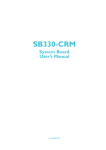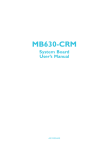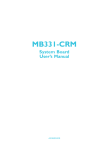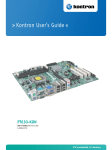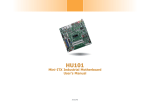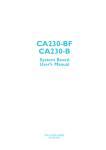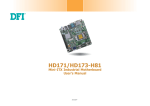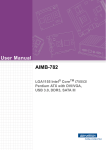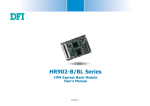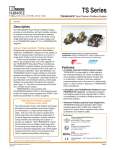Download Manual - DFI Inc.
Transcript
DT122-SB Desktop Box PC User’s Manual A25620342 1 Chapter 1 Introduction www.dfi.com Copyright FCC and DOC Statement on Class B This publication contains information that is protected by copyright. No part of it may be reproduced in any form or by any means or used to make any transformation/adaptation without the prior written permission from the copyright holders. This equipment has been tested and found to comply with the limits for a Class B digital device, pursuant to Part 15 of the FCC rules. These limits are designed to provide reasonable protection against harmful interference when the equipment is operated in a residential installation. This equipment generates, uses and can radiate radio frequency energy and, if not installed and used in accordance with the instruction manual, may cause harmful interference to radio communications. However, there is no guarantee that interference will not occur in a particular installation. If this equipment does cause harmful interference to radio or television reception, which can be determined by turning the equipment off and on, the user is encouraged to try to correct the interference by one or more of the following measures: This publication is provided for informational purposes only. The manufacturer makes no representations or warranties with respect to the contents or use of this manual and specifically disclaims any express or implied warranties of merchantability or fitness for any particular purpose. The user will assume the entire risk of the use or the results of the use of this document. Further, the manufacturer reserves the right to revise this publication and make changes to its contents at any time, without obligation to notify any person or entity of such revisions or changes. Changes after the publication’s first release will be based on the product’s revision. The website will always provide the most updated information. • • • © 2013. All Rights Reserved. • Trademarks Notice: Product names or trademarks appearing in this manual are for identification purpose only and are the properties of the respective owners. 1. 2. Reorient or relocate the receiving antenna. Increase the separation between the equipment and the receiver. Connect the equipment into an outlet on a circuit different from that to which the receiver is connected. Consult the dealer or an experienced radio TV technician for help. The changes or modifications not expressly approved by the party responsible for compliance could void the user’s authority to operate the equipment. Shielded interface cables must be used in order to comply with the emission limits. 2 Chapter 1 Introduction www.dfi.com Table of Contents DVI-I Port ................................................................................................. 22 RJ45 LAN Ports ......................................................................................... 22 USB Ports ................................................................................................. 23 Audio ........................................................................................................ 24 I/O Connectors .......................................................................................... 25 S/PDIF Connector ...................................................................................... 25 Digital I/O Connector ................................................................................. 25 SATA (Serial ATA) Connectors ..................................................................... 26 Cooling Fan Connectors ............................................................................. 26 Chassis Intrusion Connector ....................................................................... 27 Power Connectors ..................................................................................... 27 Standby Power LED ................................................................................... 28 Front Panel Connectors .............................................................................. 28 Expansion Slots ......................................................................................... 29 Battery ..................................................................................................... 29 Copyright............................................................................................................. 2 Trademarks ........................................................................................................ 2 FCC and DOC Statement on Class B ..................................................... 2 About this Manual .......................................................................................... 4 Warranty.............................................................................................................. 4 Static Electricity Precautions...................................................................... 4 Safety Measures .............................................................................................. 4 About the Package ......................................................................................... 5 Chapter 1 - Introduction ............................................................................. 6 Overview ....................................................................................................... 6 Key Features ................................................................................................ 6 Specifications ............................................................................................... 7 Getting to Know the DT122-SB .............................................................. 8 Mechanical Dimensions ............................................................................. 9 Motherboad Dimensions ........................................................................... 9 Chapter 6 - Mounting Options Chapter 7 - BIOS Setup Main ......................................................................................................... 33 Advanced .................................................................................................. 33 Chipset ..................................................................................................... 40 Boot ......................................................................................................... 44 Security .................................................................................................... 45 Save & Exit ............................................................................................... 46 Preparing the System .............................................................................. 10 Installing Devices ..................................................................................... 10 Configuring the BIOS .............................................................................. 10 Installing the Operating System .......................................................... 10 Installing the Drivers ............................................................................... 10 Updating the BIOS .............................................................. 11 ................................................................................... 46 Chapter 8 - Supported Software Installing a 2.5” or 3.5” SATA Drive ................................................... 12 Installing a 2.5” SATA Drive ....................................................................... 12 Installing a 3.5” SATA Drive ....................................................................... 14 Installing the PCI and PCIe x16 Expansion Card ............................ 15 Chapter 4 - Jumper Settings ........................................................................... 32 Overview....................................................................................................... 32 AMI BIOS Setup Utility ............................................................................. 33 Chapter 2 - Getting Started ..................................................................... 10 Chapter 3 - Installing Devices .............................................................. 30 Wall Mount................................................................................................... 30 Chapter 9 - Raid ......................................................... 47 .......................................................................................... 59 RAID Levels ............................................................................................... 59 Settings ....................................................................................................... 59 ................................................................. 17 Chapter 10 - Intel AMT Settings Clear CMOS ................................................................................................ 17 PS/2 Power Select .................................................................................... 17 USB Power Select ..................................................................................... 18 Power-on Select ........................................................................................ 18 COM 1 / COM 2 RS232/422/485 Select ............................................ 19 COM 1 / COM 2 RS232/Power Select ................................................. 19 ......................................................... 62 Overview....................................................................................................... 62 Enable Intel® AMT in the AMI BIOS ................................................... 62 Enable Intel® AMT in the Intel® Management Engine BIOS Extension (MEBX) Screen ...................................................................... 63 Appendix A - NLITE and AHCI Installation Guide ........................ 76 Chapter 5 - Ports and Connectors........................................................ 20 Appendix B - Watchdog Sample Code Bottom Panel I/O Ports ........................................................................... 20 PS/2 Mouse and PS/2 Keyboard ................................................................. 20 COM (Serial) Ports ..................................................................................... 21 VGA Port ................................................................................................... 21 Appendix C - System Error Message .............................................. 82 ................................................. 83 Appendix D - Troubleshooting Checklist .......................................... 84 3 Chapter 1 Introduction www.dfi.com About this Manual Static Electricity Precautions An electronic file of this manual is included in the CD. To view the user’s manual in the CD, insert the CD into a CD-ROM drive. The autorun screen (Main Board Utility CD) will appear. Click “User’s Manual” on the main menu. It is quite easy to inadvertently damage your PC, system board, components or devices even before installing them in your system unit. Static electrical discharge can damage computer components without causing any signs of physical damage. You must take extra care in handling them to ensure against electrostatic build-up. 1. To prevent electrostatic build-up, leave the system board in its anti-static bag until you are ready to install it. Warranty 1. 2. The warranty is void if the product has been subjected to physical abuse, improper installation, modification, accidents or unauthorized repair of the product. 3. Unless otherwise instructed in this user’s manual, the user may not, under any circumstances, attempt to perform service, adjustments or repairs on the product, whether in or out of warranty. It must be returned to the purchase point, factory or authorized service agency for all such work. 4. 2. Wear an antistatic wrist strap. Warranty does not cover damages or failures that arised from misuse of the product, inability to use the product, unauthorized replacement or alteration of components and product specifications. 3. Do all preparation work on a static-free surface. 4. Hold the device only by its edges. Be careful not to touch any of the components, contacts or connections. 5. Avoid touching the pins or contacts on all modules and connectors. Hold modules or con nectors by their ends. Important: Electrostatic discharge (ESD) can damage your processor, disk drive and other components. Perform the upgrade instruction procedures described at an ESD workstation only. If such a station is not available, you can provide some ESD protection by wearing an antistatic wrist strap and attaching it to a metal part of the system chassis. If a wrist strap is unavailable, establish and maintain contact with the system chassis throughout any procedures requiring ESD protection. We will not be liable for any indirect, special, incidental or consequencial damages to the product that has been modified or altered. Safety Measures To avoid damage to the system: • Use the correct AC input voltage range. To reduce the risk of electric shock: • Unplug the power cord before removing the system chassis cover for installation or servicing. After installation or servicing, cover the system chassis before plugging the power cord. Battery: • Danger of explosion if battery incorrectly replaced. • Replace only with the same or equivalent type recommend by the manufacturer. • Dispose of used batteries according to local ordinance. 4 Chapter 1 Introduction www.dfi.com Safety Precautions About the Package • Use the correct DC input voltage range. The package contains the following items. If any of these items are missing or damaged, please contact your dealer or sales representative for assistance. • Unplug the power cord before removing the system chassis cover for installation or servicing. After installation or servicing, cover the system chassis before plugging the power cord. • 1 DT122-SB system unit • 1 HDD drive bay kit • 1 CD disk includes - Manual - Drivers • 1 Quick Installation Guide • Danger of explosion if battery incorrectly replaced. • Replace only with the same or equivalent type recommend by the manufacturer. • Dispose of used batteries according to local ordinance. Optional Items • Keep this system away from humidity. • Power Cord • Place the system on a stable surface. Dropping it or letting it fall may cause damage. The board and accessories in the package may not come similar to the information listed above. This may differ in accordance to the sales region or models in which it was sold. For more information about the standard package in your region, please contact your dealer or sales representative. • The openings on the system are for air ventilation to protect the system from overheating. DO NOT COVER THE OPENINGS. • Place the power cord in such a way that it will not be stepped on. Do not place anything on top of the power cord. Use a power cord that has been approved for use with the system and that it matches the voltage and current marked on the system’s electrical range label. Before Using the System Before powering-on the system, prepare the basic system components. • If the system will not be used for a long time, disconnect it from the power source to avoid damage by transient overvoltage. If you are installing the system board in a new system, you will need at least the following internal components. • If one of the following occurs, consult a service personnel: - The power cord or plug is damaged. • Memory module - Liquid has penetrated the system. • Storage devices such as hard disk drive, CD-ROM, etc. - The system has been exposed to moisture. You will also need external system peripherals you intend to use which will normally include at least a keyboard, a mouse and a video display monitor. - The system is not working properly. - The system dropped or is damaged. - The system has obvious signs of breakage. • The unit uses a three-wire ground cable which is equipped with a third pin to ground the unit and prevent electric shock. Do not defeat the purpose of this pin. If your outlet does not support this kind of plug, contact your electrician to replace the outlet. • Disconnect the system from the DC outlet before cleaning. Use a damp cloth. Do not use liquid or spray detergents for cleaning. 5 Chapter 1 Introduction www.dfi.com Chapter 1 Chapter 1 - Introduction Key Features Overview DT122-SB PROCESSOR 3rd/2nd Generation Intel® CoreTM processors CHIPSET Intel® Q67 LAN 2 LAN ports COM 2 COM ports DISPLAYS DVI-I (DVI-D Signal), 1 VGA USB 4 Type A USB 2.0/1.1 ports 2 Type A USB 2.0/1.1 ports (optional) AUDIO Mic-in, Line-in, Line-out 6 Chapter 1 Introduction www.dfi.com Chapter 1 Specifications Processor System • Processors: - 3rd generation Intel® CoreTM processors (22nm process technology) : Intel® CoreTM i5-3550S (6M Cache, up to 3.7GHz); 65W : Intel® CoreTM i3-3220 (3M Cache, 3.3GHz); 55W : Intel® Pentium® G2120 (3M Cache, 3.1 GHz); 55W - 2nd generation Intel® CoreTM processors (32nm process technology) :Intel® CoreTM i3-2120 (3M Cache, 3.3 GHz); 65W :Intel® Pentium® G850 (3M Cache, 2.9 GHz); 65W • Chipset: Intel® Q67 Express chipset Memory • Two DDR3 DIMM sockets • Supports DDR3 1333/1600MHz (3rd generation processors) Supports DDR3 1066/1333MHz (2nd generation processors) • Supports up to 16GB memory Graphics • • • • Intel® HD Graphics Display ports: DVI-I (DVI-D signal) and VGA DVI-I supports up to 1920x1200 @ 60Hz resolution VGA supports up to 2048x1536 @ 75Hz resolution I/O Ports • Front Panel - 1 Power button - 1 Reset button - 2 LED indicators: Power, HDD • Rear Panel - 1 PS/2 Mouse - 1 PS/2 Keyboard - 2 DB-9 RS232/422/485 COM - 1 DB-15 VGA - 1 DVI-I (DVI-D signal) - 2 RJ45 LAN - 4 USB 2.0 - Mic-in, Line-in and Line out Expansion • 1 expansion slot - 1 PCIe x16 or 1 PCI slot Construction • Front panel: aluminum • Rear chassis: sheet metal Mounting • 2 types of wall mount bracket - Type A - Type B Storage • Up to 2 2.5" or 1 3.5" SATA drive bay • 1 optical drive bay (optional) Ethernet • Intel® WG82579LM with iAMT8.0 Gigabit Ethernet Phy • Intel® WG82574L PCI Express Gigabit Ethernet controller Audio • Realtek® ALC262 2-channel High Definition Audio COM • 2 DB-9 RS232/422/485 COM ports • 2 DB-9 RS232 COM ports (optional) USB • 4 Type A USB 2.0/1.1 ports • 2 Type A USB 2.0/1.1 ports (optional) Dimensions • 300mm x 75mm x 217mm (W x H x D) • Power type - ATX • Power input voltage - AC 100-240V, 3.5A, 250W Weight • TBD OS Support • Windows 7, Windows 7 Embedded, Windows XP, Windows XP Embedded, Linux Kernel 2.6 Power Cooling System • 1 CPU cooler Environment • Temperature - Operating: 0oC ~ 45oC - Storage: -20oC ~ 60oC • Humidity - 90% RH at 45oC, 1 week Vibration • Operating: 1G, 5~500Hz • Non-operating: 1.5G, 5~25Hz • IEC 68-2-64 compliant Shock • Operating: 3G peak acceleration (11 msec. duration) • Non-operating: 10G peak acceleration (11 msec. duration) • IEC 68-2-27 compliant • Brackets and screws (optional) 7 Chapter 1 Introduction www.dfi.com Chapter 1 Getting to Know the DT122-SB Front View Bottom View PS/2 Mouse COM 2 Reset Button Expansion slot Power LED LAN 1-2 VGA USB 2.0 COM 1 Line-in DVI-I PS/2 KB Line-out Mic-in (DVI-D Signal) Power Button HDD LED Power Button Press to power-on or power-off the system. VGA Port Reset Button Press to reset the system. DVI-I Port Used to connect a DVI device. HDD LED Indicates the status of the hard drive. COM Ports Used to connect serial devices. Power LED Indicates the power status of the system. USB Ports Used to connect USB 3.0/2.0/1.1 devices. Use to connect a VGA device. LAN Ports Used to connect the system to a local area network. Line-out Used to connect to a speaker. Line-in Used to connect any audio devices such as Hi-fi set, CD player, tape player, AM/FM radio tuner, synthesizer, etc. Mic-in Used to connect an external microphone. PS/2 KB/Mouse Used to connect a PS/2 keyboard and PS/2 mouse. Expansion Slot Used to insert an expansion card. 8 Chapter 1 Introduction www.dfi.com Chapter 1 Mechanical Dimensions Motherboard Dimensions 163.83 157.48 151.76 125.92 89.88 59.40 36.88 17.73 1.57 0.00 6.17 10.16 Rear View 10.16 0.00 217.20 22.86 46.94 Left View 74.00 Right View 300.00 Front View SB100 146.43 154.94 159.84 154.94 157.48 0.00 9.73 9 Chapter 1 Introduction www.dfi.com Chapter 2 Chapter 2 - Getting Started Preparing the System Before you start using the system, you need the following items: • • • • • • • SATA hard drive AC power adapter PS/2 or USB keyboard PS/2 or USB mouse CD-ROM drive (for installing software/drivers) Screwdriver Memory module (optional) Installing Devices The following are devices that can be installed in the system. • • • Memory module SATA hard drive Mini PCIe card Configuring the BIOS To get you started, you may need to change configurations such as the date, time and the type of hard disk drive. 1. 2. Power-on the system. After the memory test, the message “Press DEL to run setup” will appear on the screen. Press the Delete key to enter the AMI BIOS setup utility. Installing the Operating System Most operating system software are provided in a CD therefore you need to install a CD-ROM drive in order to use the CD. Make sure a SATA drive is already installed. 1. 2. Refer to the following chapters for information on connecting a CD-ROM drive and installing a SATA drive. Refer to your operating system manual for instructions on installing the operating system. Installing the Drivers The system package includes a CD disk. The CD includes drivers that must be installed to provide the best system performance. Refer to the Supported Software chapter for instructions on installing the drivers. 10 Chapter 2 Getting Started www.dfi.com Chapter 3 Chapter 3 - Installing Devices 5. The DIMM sockets and SATA drive bay are readily accessible after removing the chassis cover. 1. Make sure the system and all other peripheral devices connected to it has been powered-off. 2. Disconnect all power cords and cables. 3. The 4 mounting screws on the sides of the system are used to secure the cover to the chassis. Remove these screws and then put them in a safe place for later use. 2.5"/3.5" SATA drive bay Mounting screw DIMM socket Mounting screw 4. After removing the mounting screws, slide the cover backwards. Slide the Cover Backward 11 Chapter 3 Installing Devices www.dfi.com Chapter 3 Installing a 2.5" or 3.5" SATA Drive 3. Align the mounting holes of the SATA drive with the mounting holes on the HDD bracket and then use the provided mounting screws to secure the drive in place. Installing a 2.5” SATA Drive 1. Remove the 4 mounting screws that secure the drive bay to the chassis and then remove the drive bay. Mounting screw Mounting screw Drive bay Mounting screw 2. Turn to the other side of the drive bay and remove the 4 mounting screws that secure the HDD brackets to the drive bay. Mounting screw SATA drive HDD bracket Drive bay Mounting screw 12 Chapter 3 Installing Devices www.dfi.com Chapter 3 4. Turn to the other side of the drive bay. Use the provided mounting screws from step 2 to secure the SATA drive (with HDD bracket) onto the drive bay. 6. Connect the SATA data cable and SATA power cable to the connectors on the SATA drive. Drive bay Mounting screw Mounting screw SATA power cable SATA data cable 5. Place the SATA drive bay assembly into the chassis. Secure the SATA drive bay with the mounting screws you removed in step 1. Mounting screw Mounting screw 13 Chapter 3 Installing Devices www.dfi.com Chapter 3 lnstalling a 3.5" SATA Drive 4. Use the provided mounting screws to secure the SATA drive onto the drive bay. 1. Remove the 4 mounting screws that secure the drive bay to the system. Mounting screw Mounting screw Mounting screw Drive bay Drive bay 5. Place the drive bay into the chassis. Secure the drive bay with the mounting screws you removed in step 1. Mounting screw Mounting screw 2. Insert the spacer into the anti-shock bumper. You will find the spacers in the HDD drive bay kit that comes with the DT122 package. Mounting screw spacer spacer Drive bay 6. Connect the SATA data cable and SATA power cable to the connectors on the SATA drive. 3. Place the SATA drive on the drive bay. Align the mounting holes of the SATA drive with the mounting holes on the drive bay. SATA drive SATA data cable SATA power cable Drive bay 14 Chapter 3 Installing Devices www.dfi.com Chapter 3 Installing the PCI or PCIe x16 Expansion Card Important: When inserting the riser card, please select a card within 175mm (as shown on the next picture). Bracket Mounting bracket and mounting screw 1. The PCIe x16 on the motherboard is used to insert a TS200-1P or TS200-1E riser card. T200-1P To install the expansion card, you need to remove the mounting bracket and the mounting screw that secure the bracket to the chassis and then remove the bracket. Put the screw and the brackets in a safe place for later use. PCI slot T200-1E PCIe x16 slot Mounting screw Mounting bracket 15 Chapter 3 Installing Devices www.dfi.com Chapter 3 2. Insert the Expansion card with a bracket into the PCI or PCIe x16 slot that is on the riser card. Replace the screw you removed in step 1 to secure the bracket in place. Bracket Mounting bracket and mounting screw PCI Expansion card Rear view Note: The Expansion card used in the above illustrations may not resemble the actual cards. These illustrations are for reference only. 16 Chapter 3 Installing Devices www.dfi.com Chapter 4 Chapter 4 - Jumper Settings PS/2 Power Select Clear CMOS 1 2 3 JP9 1-2 On: Normal (default) 1 1 2 3 2 3 1-2 On: +5V (default) 2-3 On: Clear CMOS Data 1 1 2 3 JP2 2-3 On: +5V_standby 1 If you encounter the following, JP2 is used to select the power of the PS/2 keyboard and PS/2 mouse ports. Selecting +5V_ standby will allow you to use the PS/2 keyboard or PS/2 mouse to wake up the system. a) CMOS data becomes corrupted. b) You forgot the supervisor or user password. Important: The +5VSB power source of your power supply must support ≥720mA. you can reconfigure the system with the default values stored in the ROM BIOS. To load the default values stored in the ROM BIOS, please follow the steps below. 1. Power-off the system and unplug the power cord. 2. Set JP9 pins 2 and 3 to On. Wait for a few seconds and set JP9 back to its default setting, pins 1 and 2 On. 3. Now plug the power cord and power-on the system. 17 Chapter 4 Jumper Settings www.dfi.com Chapter 4 USB Power Select Power-on Select JP8 1 2 3 1-2 On: Power-on via power button (default) 1 USB 2-5 (JP7) 2-3 On: Power-on via AC power; or Power-on via WOL after G3 USB 0-1/8-9 (JP4) 1 2 3 1-2 On: +5V (default) 1 2 3 2 3 2-3 On: +5V_standby 1 1 To power-on via WOL after G3: These jumpers are used to select the power of the USB ports. Selecting +5V_standby will allow you to use a USB device to wake up the system. Important: If you are using the Wake-On-USB Keyboard/Mouse function for 2 USB ports, the +5V_standby power source of your power supply must support ≥1.5A. For 3 or more USB ports, the +5V_standby power source of your power supply must support ≥2A. 1. Set JP8 pins 2 and 3 to On. 2. Set the “After G3” field to Power Off/WOL. 3. Set the “GbE Wake Up From S5” to Enabled. The BIOS fields are in the “South Bridge Configuration” submenu (Chipset menu) of the AMI BIOS utility. To power-on via AC Power: 1. Set JP8 pins 2 and 3 to On. 2. Set the “After G3” field to Power On. 18 Chapter 4 Jumper Settings www.dfi.com Chapter 4 COM1/COM2 RS232/Power Select COM 1/ COM 2 RS232/RS422/RS485 Select JP3 JP6 JP1 JP5 COM 2 COM 1 1 1 6 JP1 (for COM1) and JP6 (for COM2) are used to configure the COM ports to RS232, RS422 (Full Duplex) or RS485. 5 1-3 (RI), 2-4 (DCD) On: RS232 (default) 4 3 2 1 6 4 5 3-5 (+5V), 4-6 (+12V) On: 3 RS232 with power 2 1 The pin function of the COM ports will vary according to the jumper’s setting. JP1/JP6 2 4 6 1 3 5 1-2 On: RS232 (default) 2 4 6 1 3 5 3-4 On: RS422 Full Duplex 2 4 6 1 3 5 5-6 On: RS485 DCDRD TD DTRGND RXD+ RXDTXD+ TXDN.C. DATA+ DATAN.C. N.C. N.C. 1 2 3 4 5 1 2 3 4 5 1 2 3 4 5 6 7 8 9 6 7 8 9 6 7 8 9 DSRRTSCTSRI- N.C. N.C. N.C. N.C. N.C. N.C. N.C. N.C. COM 1/ COM 2 RS232 RS422 Full Duplex RS485 19 Chapter 4 Jumper Settings www.dfi.com Chapter 5 Chapter 5 - Ports and Connectors PS/2 Mouse and PS/2 Keyboard Bottom Panel I/O Ports PS/2 Mouse COM 2 PS/2 Mouse LAN 1-2 PS/2 KB VGA USB 2.0 COM 1 Line-in DVI-I PS/2 KB Line-out Mic-in (DVI-D Signal) The rear panel I/O ports consist of the following: • • • • • • • • • PS/2 mouse/keyboard port COM port VGA port DVI-I port (DVI-D signal only) 2 Intel LAN ports 4 USB ports Line-out jack Line-in jack Mic-in jack 1 These ports are used to connect a PS/2 mouse and a PS/2 keyboard. The PS/2 mouse port uses IRQ12. Wake-On-PS/2 Keyboard/Mouse The Wake-On-PS/2 Keyboard/Mouse function allows you to use the PS/2 keyboard or PS/2 mouse to power-on the system. To use this function: • Jumper Setting JP2 must be set to “2-3 On: +5V_standby”. Refer to “PS/2 Power Select” in this chapter for more information. • BIOS Setting Configure the PS/2 keyboard/mouse wake up function in the Advanced menu (“ACPI Power Management Configuration” submenu) of the BIOS. Refer to chapter 7 for more information. Important: The +5V_standby power source of your power supply must support ≥720mA. 20 Chapter 5 Ports and Connectors www.dfi.com Chapter 5 COM (Serial) Ports VGA Port COM 3 COM 4 COM 2 VGA COM 1 COM 1 and COM 2: RS232/422/485 COM 3 and COM 4: RS232 1 9 1 2 1 The VGA port is used for connecting a VGA monitor. Connect the monitor’s 15-pin D-shell cable connector to the VGA port. After you plug the monitor’s cable connector into the VGA port, gently tighten the cable screws to hold the connector in place. COM 3 and COM 4 are fixed at RS232. The pin function of COM 1 and COM 2 ports will vary according to JP1/JP6’s setting. Refer to “COM1/COM2 RS232/RS422/RS485 Select” in this chapter for more information. BIOS Setting Configure VGA in the Chipset menu (“North Bridge Configuration” submenu) of the BIOS. Refer to chapter 3 for more information. The serial ports are asynchronous communication ports with 16C550A-compatible UARTs that can be used with modems, serial printers, remote display terminals, and other serial devices. Driver Installation Connecting External Serial Ports Install the graphics driver. Refer to chapter 4 for more information. Your COM port may come mounted on a card-edge bracket. Install the card-edge bracket to an available slot at the rear of the system chassis then insert the serial port cable to the COM connector. Make sure the colored stripe on the ribbon cable is aligned with pin 1 of the COM connector. BIOS Setting Configure the serial ports in the Advanced menu (“Super IO Configuration” submenu) of the BIOS. Refer to chapter 3 for more information. 21 Chapter 5 Ports and Connectors www.dfi.com Chapter 5 DVI-I Port RJ45 LAN Ports DVI-I (DVI-D signal only) LAN 1 LAN 2 1 1 The DVI-I port is used to connect an LCD monitor. This port supports DVI-D signal only. Features Connect the display device’s cable connector to the DVI-I port. After you plug the cable connector into the port, gently tighten the cable screws to hold the connector in place. • Intel W82579LM with iAMT8.0 Gigabit LAN Phy BIOS Setting • Intel W82574L PCI Express Gigabit LAN controller Configure the display device in the Chipset menu (“North Bridge Configuration” submenu) of the BIOS. Refer to chapter 3 for more information. The LAN ports allow the system board to connect to a local area network by means of a network hub. BIOS Setting Configure the onboard LAN in the Chipset menu (“South Bridge Configuration” submenu) of the BIOS. Refer to chapter 7 for more information. Driver Installation Install the LAN drivers. Refer to chapter 8 for more information. 22 Chapter 5 Ports and Connectors www.dfi.com Chapter 5 USB Ports 10 2 1 • 9 Jumper Setting JP4 and JP7 must be set to “2-3 On: +5V_standby”. Refer to “USB Power Select” in this chapter for more information. VCC -Data +Data GND Key USB 2-3 USB 4-5 The Wake-On-USB Keyboard/Mouse function allows you to use a USB keyboard or USB mouse to wake up a system from the S3 (STR - Suspend To RAM) state. To use this function: +Data GND N. C. VCC -Data Wake-On-USB Keyboard/Mouse Important: If you are using the Wake-On-USB Keyboard/Mouse function for 2 USB ports, the +5V_standby power source of your power supply must support ≥1.5A. For 3 or more USB ports, the +5V_standby power source of your power supply must support ≥2A. USB 1 USB 0 USB 9 1 USB 8 USB allows data exchange between your computer and a wide range of simultaneously accessible external Plug and Play peripherals. The system board is equipped with two onboard USB 2.0/1.1 ports. The two 10-pin connectors allow you to connect 4 additional USB 2.0/1.1 ports. The additional USB ports may be mounted on a card-edge bracket. Install the card-edge bracket to an available slot at the rear of the system chassis and then insert the USB port cables to a connector. BIOS Setting Configure the onboard USB in the Advanced menu (“USB Configuration” submenu) of the BIOS. Refer to chapter 3 for more information. Driver Installation You may need to install the proper drivers in your operating system to use the USB device. Refer to your operating system’s manual or documentation for more information. 23 Chapter 5 Ports and Connectors www.dfi.com Chapter 5 Audio BIOS Setting Configure the onboard audio in the Chipset menu (“South Bridge” submenu) of the BIOS. Refer to chapter 7 for more information. Driver Installation Rear audio Install the audio driver. Refer to chapter 8 for more information. Mic-in Line-in Presence Signal Mic2-JD Key Line2-JD GND Line-out 1 10 9 Mic2-L Mic2-R Line2-R Front_IO_Sense Line2-L 2 1 Front audio Rear Audio The system board is equipped with 3 audio jacks. A jack is a one-hole connecting interface for inserting a plug. • Mic-in Jack (Pink) This jack is used to connect an external microphone. • Line-in Jack (Light Blue) This jack is used to connect any audio devices such as Hi-fi set, CD player, tape player, AM/ FM radio tuner, synthesizer, etc. • Line-out Jack (Lime) This jack is used to connect a headphone or external speakers. Front Audio The front audio connector allows you to connect to the second line-out and mic-in jacks that are at the front panel of your system. 24 Chapter 5 Ports and Connectors www.dfi.com Chapter 5 I/O Connectors Digital I/O Connector S/PDIF Connector 1 8 +12V Ground 5VSB +5V DIO connector 1 SPDIF out Key Ground +5V 1 4 DIO power connector SPDIF in 1 5 1 The Digital I/O connector provides powering-on function to external devices that are connected to these connectors. The S/PDIF connector is used to connect an external S/PDIF port. Your S/PDIF port may be mounted on a card-edge bracket. Install the card-edge bracket to an available slot at the rear of the system chassis then connect the audio cable to the S/PDIF connector. Make sure pin 1 of the audio cable is aligned with pin 1 of the S/PDIF connector. Pin Pin Assignment Pin Pin Assignment 1 DIO7 2 DIO6 3 DIO5 4 DIO4 5 DIO3 6 DIO2 7 DIO1 8 DIO0 25 Chapter 5 Ports and Connectors www.dfi.com Chapter 5 Cooling Fan Connectors SATA (Serial ATA) Connectors SATA 3.0 6Gb/s SATA 2.0 3Gb/s SATA 0 SATA 1 SATA 4 SATA 5 7 3 1 GND RXP RXN GND TXN TXP GND Ground Sense Power System fan 1 Speed Control Sense Power Ground 4 1 CPU fan 1 The fan connectors are used to connect cooling fans. The cooling fans will provide adequate airflow throughout the chassis to prevent overheating the CPU and system board components. BIOS Setting 1 The Advanced menu (“Hardware Health Configuration” submenu) of the BIOS will display the current speed of the cooling fans. Refer to chapter 3 for more information. Features • SATA 0 and SATA 1 support data transfer rate up to 6Gb/s • SATA 4 and SATA 5 support data transfer rate up to 3Gb/s • Integrated Advanced Host Controller Interface (AHCI) controller • Supports RAID 0, RAID 1, RAID 5 and RAID 10 The Serial ATA connectors are used to connect Serial ATA devices. Connect one end of the Serial ATA cable to a SATA connector and the other end to your Serial ATA device. BIOS Setting Configure the Serial ATA drives in the Advanced menu (“IDE Configuration” submenu) of the BIOS. Refer to chapter 3 for more information. 26 Chapter 5 Ports and Connectors www.dfi.com Chapter 5 Power Connectors Chassis Intrusion Connector Ground Chassis signal 2 1 +12V +12V 1 3 4 1 2 1 Ground +3.3VDC +12VDC +5VSB +12VDC PWR_OK COM COM +5VDC COM +5VDC +3.3VDC COM +5VDC +5VDC NC +5VDC COM COM COM PS_ON# 24 COM 12 +3.3VDC Install the “MyGuard Hardware Monitor” utility. By default, the chassis intrusion detection function is disabled. When enabled, a warning message will appear when the chassis is open. The utility can also be configured so that a beeping alarm will sound when the chassis is open. Refer to the “MyGuard Hardware Monitor” section in chapter 4 for more information. 1 13 -12VDC ATX power MyGuard Hardware Monitor +3.3VDC Ground The board supports the chassis intrusion detection function. Connect the chassis intrusion sensor cable from the chassis to this connector. When the system’s power is on and a chassis intrusion occurred, an alarm will sound. When the system’s power is off and a chassis intrusion occurred, the alarm will sound only when the system restarts. Use a power supply that complies with the ATX12V Power Supply Design Guide Version 1.1. An ATX12V power supply unit has a standard 24-pin ATX main power connector that must be inserted into the 24-pin connector. The 4-pin +12V power connector enables the delivery of more +12VDC current to the processor’s Voltage Regulator Module (VRM). The power connectors from the power supply unit are designed to fit the 24-pin and 4-pin connectors in only one orientation. Make sure to find the proper orientation before plugging the connectors. Important: Insufficient power supplied to the system may result in instability or the add-in boards and peripherals not functioning properly. Calculating the system’s approximate power usage is important to ensure that the power supply meets the system’s consumption requirements. 27 Chapter 5 Ports and Connectors www.dfi.com Chapter 5 Standby Power LED Front Panel Connectors 1 Standby Power LED 2 PWR-LED HDD-LED PWR-BTN RESET-SW 11 12 1 1 This LED will lit red when the system is in the standby mode. It indicates that there is power on the system board. Power-off the PC and then unplug the power cord prior to installing any devices. Failure to do so will cause severe damage to the motherboard and components. HDD-LED - HDD LED This LED will light when the hard drive is being accessed. RESET SW - Reset Switch This switch allows you to reboot without having to power off the system. PWR-BTN - Power Switch This switch is used to power on or off the system. PWR-LED - Power/Standby LED When the system’s power is on, this LED will light. When the system is in the S1 (POS - Power On Suspend) state, it will blink every second. When the system is in the S3 (STR - Suspend To RAM) state, it will blink every 4 seconds. Pin Pin Assignment HDD-LED RESET SW Pin Pin Assignment PWR-LED 2 LED Power Signal 4 LED Power 7 Ground 6 Signal 9 RST Signal 11 N.C. 3 HDD Power 5 PWR-BTN 8 10 Ground Signal 28 Chapter 5 Ports and Connectors www.dfi.com Chapter 5 Expansion Slots Battery Battery 1 1 PCI Express x16 The lithium ion battery powers the real-time clock and CMOS memory. It is an auxiliary source of power when the main power is shut off. PCI Express x16 Slot Install PCI Express x16 graphics card, that comply to the PCI Express specifications, into the PCI Express x16 slot. To install a graphics card into the x16 slot, align the graphics card above the slot then press it down firmly until it is completely seated in the slot. The retaining clip of the slot will automatically hold the graphics card in place. Safety Measures • Danger of explosion if battery incorrectly replaced. • Replace only with the same or equivalent type recommend by the manufacturer. • Dispose of used batteries according to local ordinance. 29 Chapter 5 Ports and Connectors www.dfi.com Chapter 6 Chapter 6 - Mounting Options 2. At the sides of the system, use the mounting screws removed in step 1 to secure the wall mount brackets on each side of the system. Wall Mount There are 2 types of wall mount brackets: • Type A • Wall mount bracket Type B Wall mount bracket Mounting screw Type A wall mount kit include: • 2 type A wall mount brackets 1. If the mounting screw has been previously attached to the top cover of the system, please remove them first. Ø5.00 Ø8.50 74.00 78.00 16 16 180.00 2 4-#6-32 Ø4.00 Ø3.60 300.00 2 120.00 80.00 160.00 28.60 319.00 4.00 Mounting screw Mounting screw 30 Chapter 6 Mounting Options www.dfi.com Chapter 6 Type B wall mount kit include: • 2 type B wall mount brackets • Bracket screws 1. The 4 mounting holes on the sides of the system are used to mount the type B wall mount bracket. 300.00 335.00 360.00 4.00 R2.50 R2.50 37 55.00 40.00 5.00 16 5.00 40.00 55.00 78.00 Ø8.50 2. Use the provided mounting screws to secure the type B wall mount brackets on each side of the system. Wall mount bracket Wall mount bracket 31 Chapter 6 Mounting Options www.dfi.com Chapter 7 Chapter 7 - BIOS Setup Legends Overview The BIOS is a program that takes care of the basic level of communication between the CPU and peripherals. It contains codes for various advanced features found in this system board. The BIOS allows you to configure the system and save the configuration in a battery-backed CMOS so that the data retains even when the power is off. In general, the information stored in the CMOS RAM of the EEPROM will stay unchanged unless a configuration change has been made such as a hard drive replaced or a device added. It is possible that the CMOS battery will fail causing CMOS data loss. If this happens, you need to install a new CMOS battery and reconfigure the BIOS settings. Note: The BIOS is constantly updated to improve the performance of the system board; therefore the BIOS screens in this chapter may not appear the same as the actual one. These screens are for reference purpose only. Default Configuration Most of the configuration settings are either predefined according to the Load Optimal Defaults settings which are stored in the BIOS or are automatically detected and configured without requiring any actions. There are a few settings that you may need to change depending on your system configuration. Keys Function Right and Left arrows Moves the highlight left or right to select a menu. Up and Down arrows Moves the hightlight up or down between submenu or fields. <Esc> Exit to the BIOS Setup Utility. + (plus key) Scrolls forward through the values or options of the highlighted field. - (minus key) Scrolls backward through the values or options of the highlighted field. Tab Select a field. <F1> Displays General Help <F4> Saves and exits the Setup program. <Enter> Press <Enter> to enter the highlighted submenu. Scroll Bar Entering the BIOS Setup Utility When a scroll bar appears to the right of the setup screen, it indicates that there are more available fields not shown on the screen. Use the up and down arrow keys to scroll through all the available fields. The BIOS Setup Utility can only be operated from the keyboard and all commands are keyboard commands. The commands are available at the right side of each setup screen. Submenu The BIOS Setup Utility does not require an operating system to run. After you power up the system, the BIOS message appears on the screen and the memory count begins. After the memory test, the message “Press DEL to run setup” will appear on the screen. If the message disappears before you respond, restart the system or press the “Reset” button. You may also restart the system by pressing the <Ctrl> <Alt> and <Del> keys simultaneously. When ““ appears on the left of a particular field, it indicates that a submenu which contains additional options are available for that field. To display the submenu, move the highlight to that field and press <Enter>. 32 Chapter 7 BIOS Setup www.dfi.com Chapter 7 AMI BIOS Setup Utility Advanced Main The Advanced menu allows you to configure your system for basic operation. Some entries are defaults required by the system board, while others, if enabled, will improve the performance of your system or let you set some features according to your preference. The Main menu is the first screen that you will see when you enter the BIOS Setup Utility. Main Important: Setting incorrect field values may cause the system to malfunction. Aptio Setup Utility - Copyright (C) 2011 American Megatrends, Inc. Advanced Chipset Save & Exit Boot Security BIOS Information BIOS Vendor Core Version Compliency Project Version Build Date and Time System Language American Megatrends 4.6.5.3 UEFI 2.3; PI 1.2 1DPFA 0.21 x64 05/02/2013 13:52:59 Choose the system default language. Aptio Setup Utility - Copyright (C) 2011 American Megatrends, Inc. Main [TUE 09/03/2013] [15:01:04] Access Level Administrator Chipset ACPI Power Management PC Health Status [English] System Date System Time Advanced Boot Configuration Trusted Computing CPU Configuration SATA Configuration Security Save & Exit ACPI Power Management Configuration. Intel TXT(LT) Configuration AMT Configuration Select Screen Select Item Enter: Select +/-: Change Opt. F1: General Help F2: Previous Values F3: Optimized Defaults F4: Save & Exit ESC: Exit USB Configuration F71879 Super IO Configuration Second Super IO Network Stack Configuration Select Screen Select Item Enter: Select +/-: Change Opt. F1: General Help F2: Previous Values F3: Optimized Defaults F4: Save & Exit ESC: Exit Version 2.14.1219. Copyright (C) 2011 American Megatrends, Inc. System Date Version 2.14.1219. Copyright (C) 2011 American Megatrends, Inc. The date format is <day>, <month>, <date>, <year>. Day displays a day, from Sunday to Saturday. Month displays the month, from January to December. Date displays the date, from 1 to 31. Year displays the year, from 1980 to 2099. System Time The time format is <hour>, <minute>, <second>. The time is based on the 24-hour military-time clock. For example, 1 p.m. is 13:00:00. Hour displays hours from 00 to 23. Minute displays minutes from 00 to 59. Second displays seconds from 00 to 59. 33 Chapter 7 BIOS Setup www.dfi.com Chapter 7 ACPI Power Management Configuration PC Health Status This section is used to configure the ACPI Power Management. This section displays the SIO hardware health monitor. Aptio Setup Utility - Copyright (C) 2011 American Megatrends, Inc. Advanced Aptio Setup Utility - Copyright (C) 2011 American Megatrends, Inc. Advanced ACPI Power Management Configuration ACPI Sleep State [S1 (CPU Stop Clock) ] Resume by PME Resume by Ring Resume by RTC Alarm [Enabled] [Disabled] [Disabled] Smart Select Screen Select Item Enter: Select +/-: Change Opt. F1: General Help F2: Previous Values F3: Optimized Defaults F4: Save & Exit ESC: Exit Fan Function Case Open Beep [Disabled] CPU Temperature System Temperature CPU FAN Speed System FAN Speed Vcore +5.0V +12V VDIMM +3.3V VS5V : +57 C : +40 C : 5535 RPM : N/A : +1.032 V : +4.952 V : +12.144 V : +1.552 V : +3.248 V : +5.032V Select Screen Select Item Enter: Select +/-: Change Opt. F1: General Help F2: Previous Values F3: Optimized Defaults F4: Save & Exit ESC: Exit Version 2.14.1219. Copyright (C) 2011 American Megatrends, Inc. Version 2.14.1219. Copyright (C) 2011 American Megatrends, Inc. Smart Fan Function Aptio Setup Utility - Copyright (C) 2011 American Megatrends, Inc. Advanced ACPI Sleep State Selects the highest ACPI sleep state the system will enter when the Suspend button is pressed. S1(POS) S3(STR) Smart Fan Function System Hardware Monitor Select the highest ACPI sleep state the system will enter, when the SUSPEND button is pressed. CPU Smart Fan Control Boundary 1 Boundary 2 Boundary 3 Boundary 4 Speed Count 1 Speed Count 2 Speed Count 3 Speed Count 4 Speed Count 5 System Smart Fan(1) Control Boundary 1 Boundary 2 Boundary 3 Boundary 4 Speed Count 1 Speed Count 2 Speed Count 3 Speed Count 4 Speed Count 5 Enables the Power On Suspend function. Enables the Suspend to RAM function. Resume by PME Enable this field to use the PME signal to wake up the system. Resume by Ring Set this field to Enabled to use the modem ring-on function. This will allow your system to power-on to respond to calls coming through an external or internal modem. Resume by RTC Alarm [Automatic] 60 50 40 30 100 75 50 40 30 [Automatic] 60 50 40 30 100 75 50 40 30 Enable CPU SmartFan Select Screen Select Item Enter: Select +/-: Change Opt. F1: General Help F2: Previous Values F3: Optimized Defaults F4: Save & Exit ESC: Exit Version 2.14.1219. Copyright (C) 2011 American Megatrends, Inc. When Enabled, the system uses the RTC to generate a wakeup event. CPU Smart Fan Control When this feature is set to Automatic, the CPU’s fan speed will rotate accord ing to the CPU’s temperature. The higher the temperature, the faster the speed of rotation 34 Chapter 7 BIOS Setup www.dfi.com Chapter 7 Boundary 1 to Boundary 4 Trusted Computing (optional) The range is from 0-127. This section configures settings relevant to Trusted Computing innovations. Speed Count 1 to Speed Count 5 Aptio Setup Utility - Copyright (C) 2010 American Megatrends, Inc. Advanced The range is from 1-100. Configuration Security Device Support Case Open Beep Current Status Information NO Security Device Found Set this field to Enabled to allow the system to alert you of a chassis intrusion event. [Disabled] Enables or Disables BIOS support for security device. O.S. will not show Security Device. TCG EFI protocol and INT1A interface will not be available. Select Screen Select Item Enter: Select +/-: Change Opt. F1: General Help F2: Previous Values F3: Optimized Defaults F4: Save & Exit ESC: Exit Version 2.02.1205. Copyright (C) 2010 American Megatrends, Inc. TPM Support Enables or Disables TPM. O.S. will not show TPM. Resetting the platform is required. 35 Chapter 7 BIOS Setup www.dfi.com Chapter 7 CPU Configuration SATA Configuration This section is used to configure the CPU. It will also display the detected CPU information. This section is used to configure SATA functions. Aptio Setup Utility - Copyright (C) 2011 American Megatrends, Inc. Advanced Aptio Setup Utility - Copyright (C) 2011 American Megatrends, Inc. Advanced CPU Configuration Intel(R) Pentium(R) CPU G850 @ 2.90GHz 206a7 CPU Signature 26 Microcode Patch 2900 MHz Max CPU Speed 1600 MHz Min CPU Speed 2900 MHz CPU Speed 2 Processor Cores Not Supported Intel HT Technology Supported Intel VT-x Technology Not Supported Intel SMX Technology Supported 64-bit L1 L1 L2 L3 32 kB x 2 32 kB x 2 256 kB x 2 3072 kB Data Cache Code Cache Cache Cache Active Processor Cores Intel Virtualization Technology [All] [Disabled] Enabled for Windows XP and Linux (OS Optimised for Hyper-Threading Technology) and Disabled for other OS (OS not optimized for HyperThreading Technology) When disabled only one thread per enabled core is enabled. SATA Controller(s) SATA Mode Selection [Enabled] [IDE] Serial ATA Port 0 Software Preserve Serial ATA Port 1 Software Preserve Serial ATA Port 4 Software Preserve Serial ATA Port 5 Software Preserve Empty Unknown Empty Unknown Empty Unknown Empty Unknown Select Screen Select Item Enter: Select +/-: Change Opt. F1: General Help F2: Previous Values F3: Optimized Defaults F4: Save & Exit ESC: Exit Enable or disable SATA device. Select Screen Select Item Enter: Select +/-: Change Opt. F1: General Help F2: Previous Values F3: Optimized Defaults F4: Save & Exit ESC: Exit Version 2.14.1219. Copyright (C) 2011 American Megatrends, Inc. Version 2.14.1219. Copyright (C) 2011 American Megatrends, Inc. Active Processor Cores SATA Mode Number of cores to enable in each processor package. IDE Mode This option configures the Serial ATA drives as Parallel ATA storage devices. AHCI Mode This option allows the Serial ATA devices to use AHCI (Advanced Host Controller Interface). RAID Mode This option allows you to create RAID or Intel Matrix Storage configuration on Serial ATA devices. Intel Virtualization Technology When this field is set to Enabled, the VMM can utilize the additional hardware capabilities provided by Vanderpool Technology. SATA Mode Selection Determines how SATA controller(s) operate. 36 Chapter 7 BIOS Setup www.dfi.com Chapter 7 If AHCI or RAID is selected in the SATA Mode field, it will display the following information: Intel TXT (LT) Configuration This section is used to configure the Intel Trusted Execution technology. SATA Controller(s) SATA Mode Selection Aggressive LPM Support SATA Controller Speed [Enabled] [AHCI] [Enabled] [Gen3] Aptio Setup Utility - Copyright (C) 2011 American Megatrends, Inc. Advanced Aptio Setup Utility - Copyright (C) 2011 American Megatrends, Inc. Advanced Determines how SATA controller(s) operate. Intel Trusted Execution Technology Configuration Intel TXT support only can be enabled/disabled if SMX is enabled. VT and VT-d support must also be enabled prior to TXT. Serial ATA Port 0 Empty Software preserve Unknown Port 0 [Enabled] Hot Plug [Disabled] External SATA [Disabled] SATA device type [Hard Disk Driver] Spin up device [Disabled] Select Screen Serial ATA Port 1 Empty Select Item Software preserve Unknown Enter: Select Port 1 [Enabled] +/-: Change Opt. Hot Plug [Disabled] F1: General Help External SATA [Disabled] F2: Previous Values SATA device type [Hard Disk Driver] F3: Optimized Defaults Spin up device [Disabled] F4: Save & Exit Serial ATA Port 2 Empty ESC: Exit Software preserve Unknown Port 2 [Enabled] Hot Plug Version 2.14.1219.[Disabled] Copyright (C) 2011 American Megatrends, Inc. External SATA [Disabled] Spin up device [Disabled] Serial ATA Port 3 Empty Software preserve Unknown Port 3 [Enabled] Hot Plug [Disabled] External SATA [Disabled] Spin up device [Disabled] Serial ATA Port 4 Empty Software preserve Unknown Port 4 [Enabled] Hot Plug [Disabled] External SATA [Disabled] Spin up device [Disabled] Serial ATA Port 5 Empty Software preserve Unknown Port 5 [Enabled] Hot Plug [Disabled] External SATA [Disabled] Spin up device [Disabled] Secure Mode Extension (SMX) Enabled Intel TXT(LT) Support [Disabled] Select Screen Select Item Enter: Select +/-: Change Opt. F1: General Help F2: Previous Values F3: Optimized Defaults F4: Save & Exit ESC: Exit Version 2.14.1219. Copyright (C) 2011 American Megatrends, Inc. Intel TXT(LT) Support The options are Enabled and Disabled. Aggressive LPM Support Enable PCH to aggressively enter link power state. SATA Controller Speed Indicates the maximum speed the SATA controller can support. Serial ATA Port 0 to Serial ATA Port 5 These fields are used to configure the connected SATA devices. 37 Chapter 7 BIOS Setup www.dfi.com Chapter 7 AMT Configuration USB Configuration This section is used to configure the AMT function. This section is used to configure USB. Aptio Setup Utility - Copyright (C) 2011 American Megatrends, Inc. Advanced Intel AMT MEBx Selection Screen Un-configure ME [Enabled] [Disabled] [Disabled] Aptio Setup Utility - Copyright (C) 2011 American Megatrends, Inc. Advanced Enable or disable Intel (R) Active Management Technology. Note: iAMT H/W is always enabled. This option just controls the BIOS extension execution. If enabled, this requires additional firmware in the SPI device. USB Configuration USB Devices: 2 Hubs Legacy USB Support EHCI Hand-off Select Screen Select Item Enter: Select +/-: Change Opt. F1: General Help F2: Previous Values F3: Optimized Defaults F4: Save & Exit ESC: Exit [Enabled] [Disabled] Enables Legacy USB support. AUTO option disables legacy support if no USB devices are connected. DISABLE option will keep USB devices available only for EFI applications. Select Screen Select Item Enter: Select +/-: Change Opt. F1: General Help F2: Previous Values F3: Optimized Defaults F4: Save & Exit ESC: Exit Version 2.14.1219. Copyright (C) 2011 American Megatrends, Inc. Version 2.14.1219. Copyright (C) 2011 American Megatrends, Inc. MEBx Selection Screen Legacy USB Support OEMFLag Bit 2: enable or disable MEBx selection screen. Enabled Enables legacy USB. Auto Disables support for legacy when no USB devices are connected. Disabled Keeps USB devices available only for EFI applications. Un-configure ME OEMFLag Bit 15: Un-configure ME without password. EHCI Hand-off This is a workaround for OSes that does not support EHCI hand-off. The EHCI ownership change should be claimed by the EHCI driver. 38 Chapter 7 BIOS Setup www.dfi.com Chapter 7 Second Super IO Configuration F71879 Super IO Configuration This section is used to configure the I/O functions supported by the onboard This section is used to configure the serial port functions. Super I/O chip. Aptio Setup Utility - Copyright (C) 2011 American Megatrends, Inc. Advanced Aptio Setup Utility - Copyright (C) 2011 American Megatrends, Inc. Advanced F71879 Super IO Chip Fintek F71879 Restore AC Power Loss [Power Off] WatchDog Timer Super IO WatchDog Timer [Disabled] 10 Set Parameters of Serial Port 1 (COMA) Second Super IO Configuration Restore AC Power Loss help. F71879 Super IO Configuration Second Super IO Chip Serial Port 1 Configuration Serial Port 2 Configuration Serial Port 3 Configuration Serial Port 4 Configuration Fintek-F81217 Select Screen Select Item Enter: Select +/-: Change Opt. F1: General Help F2: Previous Values F3: Optimized Defaults F4: Save & Exit ESC: Exit Select Screen Select Item Enter: Select +/-: Change Opt. F1: General Help F2: Previous Values F3: Optimized Defaults F4: Save & Exit ESC: Exit Version 2.14.1219. Copyright (C) 2011 American Megatrends, Inc. Version 2.14.1219. Copyright (C) 2011 American Megatrends, Inc. Serial Port 1 Configuration to Serial Port 4 Configuration Restore AC Power Loss Aptio Setup Utility - Copyright (C) 2011 American Megatrends, Inc. Advanced Off When power returns after an AC power failure, the system’s power is off. You must press the Power button to power-on the system. On When power returns after an AC power failure, the system will automatically power-on. Last State When power returns after an AC power failure, the system will return to the state where you left off before power failure occurs. If the system’s power is off when AC power failure occurs, it will remain off when power returns. If the system’s power is on when AC power failure occurs, the system will power-on when power returns. Serial Port 1 Configuration Serial Port Device Settings [Enabled] IO=220h; IRQ=11; Change Settings [Auto] Enable or Disable Serial Port (COM) Select Screen Select Item Enter: Select +/-: Change Opt. F1: General Help F2: Previous Values F3: Optimized Defaults F4: Save & Exit ESC: Exit WatchDog Timer This field is used to select the time interval of the Watchdog timer. If the system hangs or fails to function, it will reset at the set time interval so that your system will continue to operate. Version 2.14.1219. Copyright (C) 2011 American Megatrends, Inc. Serial Port Enables or disables the serial port. Change Settings Selects the IO/IRQ setting of the I/O device. 39 Chapter 7 BIOS Setup www.dfi.com Chapter 7 Chipset Network Stack This section configures settings relevant to the network stack Configuration. This section is to configure relevant chipset functions. Aptio Setup Utility - Copyright (C) 2011 American Megatrends, Inc. Advanced [Enabled] Network Stack Main Enable or disable UEFI network stack. South Aptio Setup Utility - Copyright (C) 2010 American Megatrends, Inc. Advanced Boot Security Save & Exit Chipset Bridge Bridge Subsystem North Bridge Parameters North ME Select Screen Select Item Enter: Select +/-: Change Opt. F1: General Help F2: Previous Values F3: Optimized Defaults ESC: Exit Select Screen Select Item Enter: Select +/-: Change Opt. F1: General Help F2: Previous Values F3: Optimized Defaults F4: Save & Exit ESC: Exit Version 2.14.1219. Copyright (C) 2011 American Megatrends, Inc. Version 2.02.1205. Copyright (C) 2010 American Megatrends, Inc. 40 Chapter 7 BIOS Setup www.dfi.com Chapter 7 South Bridge PCI Express Configuration Aptio Setup Utility - Copyright (C) 2011 American Megatrends, Inc. Chipset Aptio Setup Utility - Copyright (C) 2011 American Megatrends, Inc. Chipset Intel PCH RC Version Intel PCH SKU name Intel PCH Rev ID PCI 1.5.0.0 Q67 05/B3 Enable/Disable LAN. PCI Express Configuration PCI Express Configuration Settings. OnBoard 82574 LAN Controller [Auto] Express Configuration Configuration USB Onboard 82579 LAN Controller Wake on LAN [Enabled] [Enabled] High Precision Event Timer Configuration High Precision Timer [Enabled] After G3 [Power on] Version 2.14.1219. Copyright (C) 2011 American Megatrends, Inc. Version 2.14.1219. Copyright (C) 2011 American Megatrends, Inc. Select Screen Select Item Enter: Select +/-: Change Opt. F1: General Help F2: Previous Values F3: Optimized Defaults F4: Save & Exit ESC: Exit Select Screen Select Item Enter: Select +/-: Change Opt. F1: General Help F2: Previous Values F3: Optimized Defaults F4: Save & Exit ESC: Exit USB Configuration Onboard 82579 LAN Controller Enables or disables LAN. Aptio Setup Utility - Copyright (C) 2011 American Megatrends, Inc. Chipset Wake on LAN USB Configuration Enabled or disable intergrated LAN to wake the system. (The Wake On LAN cannot be disabled if ME is on at Sx state.) EHCI 1 [Enabled] EHCI 2 [Enabled] High Precision Timer USB USB USB USB USB USB USB USB USB [Enabled] [Enabled] [Enabled] [Enabled] [Enabled] [Enabled] [Enabled] [Enabled] [Enabled] Enables or disables the high precision event timer. After G3 Power Off / WOL Power-on the system via WOL after G3. Power On Power-on the system after G3. Ports Per-Port Disable Control Port #0 Disable Port #1 Disable Port #2 Disable Port #3 Disable Port #4 Disable Port #5 Disable Port #8 Disable Port #9 Disable Control the USB EHCI (USB 2.0) functions. One EHCI controller must always be enabled. Select Screen Select Item Enter: Select +/-: Change Opt. F1: General Help F2: Previous Values F3: Optimized Defaults F4: Save & Exit ESC: Exit Version 2.14.1219. Copyright (C) 2011 American Megatrends, Inc. EHCI Controller 1 and EHCI Controller 2 These fields are used to enable or disable Enhanced Host Controller Interface (USB 2.0). USB Ports Per-Port Disable Control Control each of the USB ports (0-13) disabling. USB Port 0 to USB Port 9 Enables or disables the selected USB port. 41 Chapter 7 BIOS Setup www.dfi.com Chapter 7 North Bridge Graphics Configuration Aptio Setup Utility - Copyright (C) 2011 American Megatrends, Inc. Chipset System Agent Bridge Name System Agent RC Version VT-d Capability Sandy Bridge 1.5.0.0 Unsupported Aptio Setup Utility - Copyright (C) 2011 American Megatrends, Inc. Chipset Check to enable VT-d function on MCH Graphics Configuration NB PCIe Configuration Memory Configuration Graphics Configuration IGFX VBIOS Version IGfx Frequency 2137 350 MHz Primary Display Internal Graphics DVMT Pre-Allocated DVMT Total Gfx Mem [Auto] [Auto] [64M] [256M] Select Screen Select Item Enter: Select +/-: Change Opt. F1: General Help F2: Previous Values F3: Optimized Defaults F4: Save & Exit ESC: Exit Select which of IGFX/ PEG/PCI graphics device should be primary display or select SG for switchable Gfx. Select Screen Select Item Enter: Select +/-: Change Opt. F1: General Help F2: Previous Values F3: Optimized Defaults F4: Save & Exit ESC: Exit Version 2.14.1219. Copyright (C) 2011 American Megatrends, Inc. Version 2.14.1219. Copyright (C) 2011 American Megatrends, Inc. Internal Graphics Keep IGD enabled based on the setup options. DVMT Pre-Allocated Select DVMT 5.0 Pre-Allocated (Fixed) Graphics Memory size used by the internal graphics device. DVMT Total Gfx Memory Select DVMT 5.0 Total Graphics Memory size used by the internal graphics device. 42 Chapter 7 BIOS Setup www.dfi.com Chapter 7 Memory Configuration NB PCIe Configuration Aptio Setup Utility - Copyright (C) 2011 American Megatrends, Inc. Chipset Aptio Setup Utility - Copyright (C) 2011 American Megatrends, Inc. Chipset NB PCIe Configuration PEG PEG- Gen x Not Present [Gen1] Enable PEG [Enabled] Memory Information Configure PEG B0:D1:F0 Gen1-Gen3. Memory RC Version Memory Frequency Total Memory DIMM#0 DIMM#1 CAS Latency (tCL) Minimum delay time CAS to RAS (tRCDmin) ROW Precharge (tRPmin) Active to Precharge (tRASmin) XMP Profile 1 XMP Profile 2 Select Screen Select Item Enter: Select +/-: Change Opt. F1: General Help F2: Previous Values F3: Optimized Defaults F4: Save & Exit ESC: Exit 1.5.0.0 1333 Mhz 2048 MB (DDR3) Not Present 2048 MB (DDR3) 9 9 9 24 Not Supported Not Supported Select Screen Select Item Enter: Select +/-: Change Opt. F1: General Help F2: Previous Values F3: Optimized Defaults F4: Save & Exit ESC: Exit Version 2.14.1219. Copyright (C) 2011 American Megatrends, Inc. Version 2.14.1219. Copyright (C) 2011 American Megatrends, Inc. Enable PEG To enable or disable the PEG. 43 Chapter 7 BIOS Setup www.dfi.com Chapter 7 Boot ME Subsystem Aptio Setup Utility - Copyright (C) 2011 American Megatrends, Inc. Aptio Setup Utility - Copyright (C) 2011 American Megatrends, Inc. Chipset Intel ME Subsystem Configuration ME FW Version Me FW Image Re-Flash Main Advanced Chipset Boot N/A Boot Configuration Setup Prompt Timeout Bootup NumLock State 1 [On] [Disable] Quiet Boot [Disabled] CSM16 Module Version 07.69 Security Save & Exit Number of seconds to wait for setup activation key. 65535(0xFFFF) means indefinite waiting. Boot Option Priorities Select Screen Select Item Enter: Select +/-: Change Opt. F1: General Help F2: Previous Values F3: Optimized Defaults F4: Save & Exit ESC: Exit CSM parameters Select Screen Select Item Enter: Select +/-: Change Opt. F1: General Help F2: Previous Values F3: Optimized Defaults F4: Save & Exit ESC: Exit Version 2.14.1219. Copyright (C) 2011 American Megatrends, Inc. Version 2.14.1219. Copyright (C) 2011 American Megatrends, Inc. Me FW Image Re-Flash Setup Prompt Timeout Enables or disables Me FW Image Re-Flash function. Selects the number of seconds to wait for the setup activation key. 65535(0xFFFF) denotes indefinite waiting. Bootup NumLock State This allows you to determine the default state of the numeric keypad. By default, the system boots up with NumLock on wherein the function of the numeric keypad is the number keys. When set to Off, the function of the numeric keypad is the arrow keys. Quiet Boot Enables or disables the quiet boot function. 44 Chapter 7 BIOS Setup www.dfi.com Chapter 7 Security CSM Parameters Aptio Setup Utility - Copyright (C) 2011 American Megatrends, Inc. Aptio Setup Utility - Copyright (C) 2011 American Megatrends, Inc. Main Boot Launch CSM Boot option filter Launch PXE OpROM policy Launch Storage OpROM policy [Enabled] [UEFI and Legacy] [Do not launch] [Legacy only] Other PCI device ROM priority [UEFI OpROM] Advanced Chipset Boot Password Description This option controls if CSM will be launched. If ONLY the Administrator’s password is set, then this only limits access to Setup and is only asked for when entering Setup. If ONLY the User’s password is set, then this is a power on password and must be entered to boot or enter Setup. In Setup the User will have Administrator rights. The password lenth must be in the following range: Minimum lenth 3 Maximum lenth 20 Select Screen Select Item Enter: Select +/-: Change Opt. F1: General Help F2: Previous Values F3: Optimized Defaults F4: Save & Exit ESC: Exit Administrator Password User Password UEFI Secure Boot Management Security Save & Exit Set Setup Administrator Password Select Screen Select Item Enter: Select +/-: Change Opt. F1: General Help F2: Previous Values F3: Optimized Defaults F4: Save & Exit ESC: Exit Version 2.14.1219. Copyright (C) 2011 American Megatrends, Inc. Version 2.14.1219. Copyright (C) 2011 American Megatrends, Inc. Boot option filter Administrator Password This option controls what devices system can boot to. Sets the administrator password. Launch PXE OpROM policy User Password Controls the execution of UEFI and Legacy PXE OpROM. Sets the user password. Launch Storage OpROM policy Controls the execution of UEFI and Legacy Storage OpROM. Other PCI device ROM priority For PCI devices other than Network, Mass storage or video defines which OpROM to launch. 45 Chapter 7 BIOS Setup www.dfi.com Chapter 7 Save & Exit Updating the BIOS To update the BIOS, you will need the new BIOS file and a flash utility, AFUDOS.EXE. Please contact technical support or your sales representative for the files. Aptio Setup Utility - Copyright (C) 2011 American Megatrends, Inc. Main Advanced Chipset Boot Security Save Changes and Reset Discard Changes and Reset Save & Exit To execute the utility, type: Reset the system after saving the changes. A:> AFUDOS BIOS_File_Name /b /p /n Restore Defaults Boot Override then press <Enter>. Launch EFI Shell from file system device C:\AFU\AFUDOS>afudos filename /B /P /N +--------------------------------------------------------------------------------------------------------+ | AMI Firmware Update Utility(APTIO) v2.25 | Copyright (C)2008 American Megatrends Inc. All Rights Reserved. +--------------------------------------------------------------------------------------------------------+ Select Screen Select Item Enter: Select +/-: Change Opt. F1: General Help F2: Previous Values F3: Optimized Defaults F4: Save & Exit ESC: Exit Reading file .............................. Erasing flash ............................. Writing flash ............................. Verifying flash .......................... Erasing BootBlock .................... Writing BootBlock .................... Verifying BootBlock ................. Version 2.14.1219. Copyright (C) 2011 American Megatrends, Inc. | | done done done done done done done C:\AFU\AFUDOS> Save Changes and Reset To save the changes, select this field and then press <Enter>. A dialog box will appear. Select Yes to reset the system after saving all changes made. Discard Changes and Reset To discard the changes, select this field and then press <Enter>. A dialog box will appear. Select Yes to reset the system setup without saving any changes. Restore Defaults To restore and load the optimized default values, select this field and then press <Enter>. A dialog box will appear. Select Yes to restore the default values of all the setup options. Launch EFI Shell from file system device Attempts to launch EFI shell application (Shellx64.efi) from one of the available filesystem devices. 46 Chapter 7 BIOS Setup www.dfi.com Chapter 8 Chapter 8 - Supported Software Intel Chipset Software Installation Utility The CD that came with the system board contains drivers, utilities and software applications required to enhance the performance of the system board. The Intel Chipset Software Installation Utility is used for updating Windows® INF files so that the Intel chipset can be recognized and configured properly in the system. Insert the CD into a CD-ROM drive. The autorun screen (Mainboard Utility CD) will appear. If after inserting the CD, “Autorun” did not automatically start (which is, the Mainboard Utility CD screen did not appear), please go directly to the root directory of the CD and double-click “Setup”. To install the utility, click “Intel Chipset Software Installation Utility” on the main menu. 1. Setup is now ready to install the utility. Click Next. 2. Read the license agreement then click Yes. 47 Chapter 8 Supported Software www.dfi.com Chapter 8 Microsoft DirectX 9.0C (for Windows XP only) 3. Go through the readme document for system requirements and installation tips then click Next. To install the utility, click “Microsoft DirectX 9.0C” on the main menu. 1. Click “I accept the agreement” then click Next. 4. Setup is now installing the driver. Click Next to continue. 2. To start installation, click Next. 5. Click “Yes, I want to restart this computer now” then click Finish. Restarting the system will allow the new software installation to take effect. 3. Click Finish. Reboot the system for DirectX to take effect. 48 Chapter 8 Supported Software www.dfi.com Chapter 8 Microsoft .NET Framework 3.5 (for Windows XP only) 3. Click Exit. Note: Before installing Microsoft .NET Framework 3.5, make sure you have updated your Windows XP operating system to Service Pack 3. To install the driver, click “Microsoft .NET Framework 3.5” on the main menu. 1. Read the license agreement carefully. Click “I have read and accept the terms of the License Agreement” then click Install. 2. Setup is now installing the driver. 49 Chapter 8 Supported Software www.dfi.com Chapter 8 Intel Graphics Drivers (for Windows Vista) 2. Read the license agreement then click Yes. To install the driver, click “Intel Graphics Drivers” on the main menu. 1. Setup is now ready to install the graphics driver. Click Next. 3. Go through the readme document for system requirements and installation tips then click Next. By default, the “Automatically run WinSAT and enable the Windows Aero desktop theme” is enabled. With this enabled, after installing the graphics driver and the system rebooted, the screen will turn blank for 1 to 2 minutes (while WinSAT is running) before the Windows Vista desktop appears. The “blank screen” period is the time Windows is testing the graphics performance. We recommend that you skip this process by disabling this function then click Next. 4. Setup is currently installing the driver. After installation has completed, click Next. 50 Chapter 8 Supported Software www.dfi.com Chapter 8 Intel Graphics Drivers (for Windows XP) 5. Click “Yes, I want to restart this computer now” then click Finish. To install the driver, click “Intel Graphics Drivers” on the main menu. Restarting the system will allow the new software installation to take effect. 1. Setup is ready to install the graphics driver. Click Next. 2. Read the license agreement then click Yes. 3. Go through the readme document for more installation tips then click Next. 51 Chapter 8 Supported Software www.dfi.com Chapter 8 Audio Drivers 4. Setup is currently installing the driver. After installation has completed, click Next. To install the driver, click “Audio Drivers” on the main menu. 1. Setup is now ready to install the audio driver. Click Next. 2. Follow the remainder of the steps on the screen; clicking “Next” each time you finish a step. 5. Click “Yes, I want to restart this computer now.” then click Finish. 3. Click “Yes, I want to restart my computer now” then click Finish. Restarting the system will allow the new software installlation to take effect. Restarting the system will allow the new software installation to take effect. 52 Chapter 8 Supported Software www.dfi.com Chapter 8 Intel LAN Drivers 4. Click Install to begin the installation. To install the driver, click “Intel LAN Drivers” on the main menu. 1. Setup is ready to install the driver. Click Next. 5. After completing installation, click Finish. 2. Click “I accept the terms in the license agreement” then click “Next”. 3. Select the program featuers you want installed then click Next. 53 Chapter 8 Supported Software www.dfi.com Chapter 8 Intel Management Engine Interface 4. Setup is currently installing the driver. After installation has completed, click Next. To install the driver, click “Intel Management Engine Interface” on the main menu. 1. Setup is ready to install the driver. Click Next. 5. After completing installation, click Finish. 2. Read the license agreement then click Yes. 3. Go through the readme document for more installation tips then click Next. 54 Chapter 8 Supported Software www.dfi.com Chapter 8 MyGuard Hardware Monitor 7. Setup is currently installing the utility. 1. Locate for the MyGuard folder in the provided disc. 2. In the MyGuard folder, right-click on the “setup” file. 3. Select Run As Administrator. 4. Double-click Setup. Important: Perform steps 1-3 only when using Windows 7 or Windows Vista. 8. After completing installation, click Finish to exit setup. 5. Setup is ready to install the utility. Click Next. 6. Click Install to begin installation. 55 Chapter 8 Supported Software www.dfi.com Chapter 8 F6 Floppy Configuration Utility Adobe Acrobat Reader 9.3 This is used to create a floppy driver diskette needed when you install Windows XP using the F6 installation method. This will allow you to install the operating system onto a hard drive when in AHCI mode. To install the reader, click “Adobe Acrobat Reader 9.3” on the main menu. ® 1. Click Next to install or click Change Destination Folder to select another folder. 1. Insert a blank floppy diskette. 2. Locate for the drivers in the CD then copy them to the floppy diskette. The CD includes drivers for both 32-bit and 64-bit operating systems. The path to the drivers are shown below. 32-bit CD Drive:\AHCI_RAID\F6FLOPPY\f6flpy32 64-bit CD Drive:\AHCI_RAID\F6FLOPPY\f6flpy64 2. Click Install to begin installation. 3. Click Finish to exit installation. 56 Chapter 8 Supported Software www.dfi.com Chapter 8 Infineon TPM Driver and Tool (optional) 4. Click “I accept the terms in the license agreement” and then click “Next”. To install the driver, click “Infineon TPM driver and tool (option)” on the main menu. 1. TPM requires installing the Microsoft Visual C++ package prior to installing the driver. Click Install. 5. Enter the necessary information and then click Next. 2. The setup program is preparing to install the driver. 6. Select a setup type and then click Next. 3. The setup program is ready to install the driver. Click Next. 57 Chapter 8 Supported Software www.dfi.com Chapter 8 7. Click Install. 10. Click Yes to restart the system. Restarting the system will allow the new software installation to take effect. 8. The setup program is currently installing the driver. 9. Click Finish. 58 Chapter 8 Supported Software www.dfi.com Chapter 9 Chapter 9 - Raid Settings The system board allows configuring RAID on Serial ATA drives. It supports RAID 0, RAID 1, RAID 5 and RAID 10. To enable the RAID function, the following settings are required. RAID Levels 1. Connect the Serial ATA drives. RAID 0 (Striped Disk Array without Fault Tolerance) 2. Configure Serial ATA in the AMI BIOS. RAID 0 uses two new identical hard disk drives to read and write data in parallel, interleaved stacks. Data is divided into stripes and each stripe is written alternately between two disk drives. This improves the I/O performance of the drives at different channel; however it is not fault tolerant. A failed disk will result in data loss in the disk array. 3. Configure RAID in the RAID BIOS. 4. Install the RAID driver during OS installation. 5. Install the Intel Rapid Storage Drivers. RAID 1 (Mirroring Disk Array with Fault Tolerance) Step 1: Connect the Serial ATA Drives RAID 1 copies and maintains an identical image of the data from one drive to the other drive. If a drive fails to function, the disk array management software directs all applications to the other drive since it contains a complete copy of the drive’s data. This enhances data protection and increases fault tolerance to the entire system. Use two new drives or an existing drive and a new drive but the size of the new drive must be the same or larger than the existing drive. Refer to chapter 2 for details on connecting the Serial ATA drives. Important: 1. Make sure you have installed the Serial ATA drives and connected the data cables otherwise you won’t be able to enter the RAID BIOS utility. RAID 5 2. Treat the cables with extreme caution especially while creating RAID. A damaged cable will ruin the entire installation process and operating system. The system will not boot and you will lost all data in the hard drives. Please give special attention to this warning because there is no way of recovering back the data. RAID 5 stripes data and parity information across hard drives. It is fault tolerant and provides better hard drive performance and more storage capacity. RAID 10 (Mirroring and Striping) Step 2: Configure Serial ATA in the AMI BIOS RAID 10 is a combination of data striping and data mirroring providing the benefits of both RAID 0 and RAID 1. Use four new drives or an existing drive and three new drives for this configuration. 1. Power-on the system then press <Del> to enter the main menu of the AMI BIOS. 2. Configure Serial ATA in the appropriate fields. 3. Save the changes in the Save & Exit menu. 4. Reboot the system. Step 3: Configure RAID in the RAID BIOS When the system powers-up and all drives have been detected, the Intel RAID BIOS status message screen will appear. Press the <Ctrl> and <I> keys simultaneously to enter the utility. The utility allows you to build a RAID system on Serial ATA drives. 59 Chapter 9 Raid www.dfi.com Chapter 9 Step 4: Install the RAID Driver During OS Installation Step 5: Install the Intel Rapid Storage Drivers The RAID driver must be installed during the Windows® XP or Windows® 2000 installation using the F6 installation method. This is required in order to install the operating system onto a hard drive or RAID volume when in RAID mode or onto a hard drive when in AHCI mode. The Intel Rapid Storage Drivers can be installed from within Windows. It allows RAID volume management (create, delete, migrate) from within the operating system. It will also display useful SATA device and RAID volume information. The user interface, tray icon service and monitor service allow you to monitor the current status of the RAID volume and/or SATA drives. It enables enhanced performance and power management for the storage subsystem. 1. Start Windows Setup by booting from the installation CD. 2. Press <F6> when prompted in the status line with the ‘Press F6 if you need to install a third party SCSI or RAID driver’ message. 1. Insert the provided CD into an optical drive. 2. Click “Intel Rapid Storage Technology for Raid/AHCI” on the main menu. 3. Press <S> to “Specify Additional Device”. 4. At this point you will be prompted to insert a floppy disk containing the RAID driver. Insert the RAID driver diskette. 3. Setup is ready to install the utility. Click Next. 5. Locate for the drive where you inserted the diskette then select RAID or AHCI controller that corresponds to your BIOS setup. Press <Enter> to confirm. You have successfully installed the driver. However you must continue installing the OS. Leave the floppy disk in the floppy drive until the system reboots itself because Windows setup will need to copy the files again from the floppy disk to the Windows installation folders. After Windows setup has copied these files again, remove the floppy diskette so that Windows setup can reboot as needed. 4. Read the warning carefully then click Next. 60 Chapter 9 Raid www.dfi.com Chapter 9 5. Read the license agreement then click Yes. 8. Click “Yes, I want to restart my computer now” then click Finish. 6. Go through the readme document to view system requirements and installation information then click Next. 7. Setup is currently installing the driver. After installation has completed, click Next. 61 Chapter 9 Raid www.dfi.com Chapter 10 Chapter 10 - Intel AMT Settings Enable Intel® AMT in the AMI BIOS Overview 1. Power-on the system then press <Del> to enter the main menu of the AMI BIOS. Intel Active Management Technology (Intel® AMT) combines hardware and software solution to provide maximum system defense and protection to networked systems. 2. In the Advanced menu, select AMT Configuration. The hardware and software information are stored in non-volatile memory. With its built-in manageability and latest security applications, Intel® AMT provides the following functions. • Aptio Setup Utility - Copyright (C) 2011 American Megatrends, Inc. Main Discover Boot Security Configuration Save & Exit ACPI Power Management Configuration. CPU Configuration SATA Configuration Intel TXT(LT) Configuration AMT Configuration USB Configuration F71879 Super IO Configuration F81217 Second Super IO Configuration Repair Network Remotely repair systems after OS failures. Alerting and event logging help detect problems quickly to reduce downtime. • Chipset ACPI Power Management PC Health Status Trusted Computing Allows remote access and management of networked systems even while PCs are powered off; significantly reducing desk-side visits. • Advanced Stack Select Screen Select Item Enter: Select +/-: Change Opt. F1: General Help F2: Previous Values F3: Optimized Defaults F4: Save & Exit ESC: Exit Protect Intel AMT’s System Defense capability remotely updates all systems with the latest security software. It protects the network from threats at the source by proactively blocking incoming threats, reactively containing infected clients before they impact the network, and proactively alerting when critical software agents are removed. Version 2.14.1219. Copyright (C) 2011 American Megatrends, Inc. 3. In the Advanced menu, select Enable in the AMT field. Aptio Setup Utility - Copyright (C) 2011 American Megatrends, Inc. Advanced Intel AMT MEBx Selection Screen Un-configure ME [Enabled] [Disabled] [Disabled] Enable or disable Intel (R) Active Management Technology. Note: iAMT H/W is always enabled. This option just controls the BIOS extension execution. If enabled, this requires additional firmware in the SPI device. Select Screen Select Item Enter: Select +/-: Change Opt. F1: General Help F2: Previous Values F3: Optimized Defaults F4: Save & Exit ESC: Exit Version 2.14.1219. Copyright (C) 2011 American Megatrends, Inc. 62 Chapter 10 Intel AMT Settings www.dfi.com Chapter 10 Enable Intel® AMT in the Intel® Management Engine BIOS Extension (MEBX) Screen 4. In the Save & Exit menu, select Save Changes and Reset then select OK. Aptio Setup Utility - Copyright (C) 2011 American Megatrends, Inc. Main Advanced Chipset Boot Save Changes and Reset Discard Changes and Reset Security 1. When the system reboots, the following message will be displayed. Press <Ctrl-P> as soon as the message is displayed; as this message will be displayed for only a few seconds. Save & Exit Reset the system after saving the changes. Restore Defaults Boot Override American Megatrends Launch EFI Shell from file system device Select Screen Select Item Enter: Select +/-: Change Opt. F1: General Help F2: Previous Values F3: Optimized Defaults F4: Save & Exit ESC: Exit Version 2. 14. 1219. Copyright (C) 2011 American Megatrends, Inc. BIOS Date: 02/17/2012 18:13:29 Ver: 1APTJ Press <Ctrl+P> to enter MEBS setup menu Press <Del> or <F2> to enter setup Version 2.14.1219. Copyright (C) 2011 American Megatrends, Inc. 2. You will be prompted for a password. The default password is “admin”. Enter the default password in the space provided under Intel(R) ME Password then press Enter. Intel(R) Management Engine BIOS Extension v8.0.0.0061/Intel(R) ME v8.0.4.1441 Copyright(C) 2003-12 Intel Corporation. All Rights Reserved. Main Menu MEBx Login > Intel (R) ME General Settings > Intel (R) AMT Configuration MEBx Exit Intel (R) ME Password [] = Move highlight [ENTER] = Select Entry [ESC]= Exit 63 Chapter 10 Intel AMT Settings www.dfi.com Chapter 10 4. You will be asked to verify the password. Enter the same new password in the space provided under Verify Password then press Enter. 3. Enter a new password in the space provided under Intel(R) ME New Password then press Enter. The password must include: • • • • • 8-32 characters Strong 7-bit ASCII characters excluding : , and ” characters At least one digit character (0, 1, ...9) At least one 7-bit ASCII non alpha-numeric character, above 0x20, (e.g. !, $, ;) Both lower case and upper case characters Intel(R) Management Engine BIOS Extension v8.0.0.0061/Intel(R) ME v8.0.4.1441 Copyright(C) 2003-12 Intel Corporation. All Rights Reserved. Main Menu MEBx Login > Intel (R) ME General Settings > Intel (R) AMT Configuration MEBx Exit Intel(R) Management Engine BIOS Extension v8.0.0.0061/Intel(R) ME v8.0.4.1441 Copyright(C) 2003-12 Intel Corporation. All Rights Reserved. Main Menu Verify Password MEBx Login > Intel (R) ME General Settings > Intel (R) AMT Configuration MEBx Exit Intel (R) ME Password Intel (R) ME Password [] = Move highlight [ESC]= Exit 5. Select Intel(R) ME General Settings then press Enter. Intel (R) ME Password [] = Move highlight [ENTER] = Select Entry [ENTER] = Select Entry Intel(R) Management Engine BIOS Extension v8.0.0.0061/Intel(R) ME v8.0.4.1441 Copyright(C) 2003-12 Intel Corporation. All Rights Reserved. Main Menu [ESC]= Exit > Intel (R) ME General Settings > Intel (R) AMT Configuration MEBx Exit [] = Move highlight [ENTER] = Select Entry [ESC]= Exit 64 Chapter 10 Intel AMT Settings www.dfi.com Chapter 10 7. 6. Select Change Intel(R) ME Password then press Enter. You will be prompted for a password. The default password is “admin”. Enter the default password in the space provided under Intel(R) ME New Password then press Enter. • • • • • Select Local FW Update then press Enter. Select Enabled then press Enter. Intel(R) Management Engine BIOS Extension v8.0.0.0061/Intel(R) ME v8.0.4.1441 Copyright(C) 2003-12 Intel Corporation. All Rights Reserved. 8-32 characters Strong 7-bit ASCII characters excluding : , and ” characters At least one digit character (0, 1, ...9) At least one 7-bit ASCII non alpha-numeric character, above 0x20, (e.g. !, $, ;) Both lower case and upper case characters INTEL (R) ME PLATFORM CONFIGURATION > Change ME Password Local FW Updtate > Power Control Disabled Enabled Password Protected Intel(R) Management Engine BIOS Extension v8.0.0.0061/Intel(R) ME v8.0.4.1441 Copyright(C) 2003-12 Intel Corporation. All Rights Reserved. INTEL (R) ME PLATFORM CONFIGURATION > Change ME Password Local FW Updtate > Power Control <Enabled> <Enabled> <ENTER> = Complete Entry 8. Intel (R) ME New Password [] = Move highlight [ENTER] = Select Entry [ESC]= Discard Changes In the Intel(R) ME Platform Configuration menu, select Power Control then press Enter. Intel(R) Management Engine BIOS Extension v8.0.0.0061/Intel(R) ME v8.0.4.1441 Copyright(C) 2003-12 Intel Corporation. All Rights Reserved. [ESC]= Exit INTEL (R) ME PLATFORM CONFIGURATION > Change ME Password Local FW Updtate > Power Control <Enabled> Intel (R) ME New Password [] = Move highlight [ENTER] = Select Entry [ESC]= Exit 65 Chapter 10 Intel AMT Settings www.dfi.com Chapter 10 9. 11. In the Intel(R) ME Power Control menu, select Intel(R) ME ON in Host Sleep States then press Enter. Select an option then press Enter. Intel(R) Management Engine BIOS Extension v8.0.0.0061/Intel(R) ME v8.0.4.1441 Copyright(C) 2003-12 Intel Corporation. All Rights Reserved. Intel(R) Management Engine BIOS Extension v8.0.0.0061/Intel(R) ME v8.0.4.1441 Copyright(C) 2003-12 Intel Corporation. All Rights Reserved. INTEL (R) AMT CONFIGURATION INTEL (R) ME POWER CONTROL Intel (R) ME ON in Host Sleep States Idle Timeout Manageability Feature Selection > SOL/ IDER/ KVM > User Consent Password Policy > Network Setup Activate Netwok Access Unconfigure Network Access > Remote Setup And Configuration <Desktop: ON in S0> 1 Desktop: ON in S0 Desktop: ON in S0, ME Wake in S3, S4-5 [] = Move highlight [] = Move highlight [ENTER] = Select Entry [ESC]= Discard changes 12. 10. In the Intel(R) ME Power Control menu, select Idle Timeout then press Enter. Enter the timeout value. < Enabled> <Anytime> <Full Unprovision> [ENTER] = Select Entry [ESC]= Exit In the Intel(R) AMT Configuration menu, select Manageability Feature Selection then press Enter. Select disabled then press Enter. Intel(R) Management Engine BIOS Extension v8.0.0.0061/Intel(R) ME v8.0.4.1441 Copyright(C) 2003-12 Intel Corporation. All Rights Reserved. INTEL (R) AMT CONFIGURATION Intel(R) Management Engine BIOS Extension v8.0.0.0061/Intel(R) ME v8.0.4.1441 Copyright(C) 2003-12 Intel Corporation. All Rights Reserved. Manageability Feature Selection > SOL/ IDER/ KVM > User Consent Password Policy > Network Setup Activate Netwok Access Disabled Enabled Unconfigure Network Access INTEL (R) ME POWER CONTROL Intel (R) ME ON in Host Sleep States Idle Timeout Select Previous Menu until you return to the Main Menu. Select Intel(R) AMT Configuration then press Enter. <Desttop ON in S0> 1 < Enabled> <Anytime> <Full Unprovision> > Remote Setup And Configuration Timeout Value (1-65535) 1_ <ENTER> = Complete Entry <ENTER> = Complete Entry [ESC]= Discard Changes [ESC]= Discard Changes 66 Chapter 10 Intel AMT Settings www.dfi.com Chapter 10 13. In the Intel(R) AMT Configuration menu, select SOL/IDER/KVM then press Enter. 15. In the SOL/IDER/KVM menu, select SOL then press Enter. Select disabled then press Enter. Intel(R) Management Engine BIOS Extension v8.0.0.0061/Intel(R) ME v8.0.4.1441 Copyright(C) 2003-12 Intel Corporation. All Rights Reserved. Intel(R) Management Engine BIOS Extension v8.0.0.0061/Intel(R) ME v8.0.4.1441 Copyright(C) 2003-12 Intel Corporation. All Rights Reserved. SOL/ IDER/ KVM SOL/ IDER/ KVM Username and password SOL IDER KVM Feature Selection Legacy Redirection Mode < Enabled> <Enabled> <Enabled> <Enabled> <Disabled> Username and password SOL IDER KVM Feature Selection Legacy Redirection Mode < Enabled> <Enabled> <Enabled> <Enabled> <Disabled> Disabled Enabled Menu for FW Redirection Configuration [] = Move highlight 14. [ENTER] = Select Entry [ESC]= Exit <ENTER> = Complete Entry In the SOL/IDER/KVM menu, select Username and Password then press Enter. Select disabled then press Enter. 16. Intel(R) Management Engine BIOS Extension v8.0.0.0061/Intel(R) ME v8.0.4.1441 Copyright(C) 2003-12 Intel Corporation. All Rights Reserved. SOL/ IDER/ KVM < Enabled> <Enabled> <Enabled> <Enabled> <Disabled> Username and password SOL IDER KVM Feature Selection Legacy Redirection Mode Disabled Enabled <ENTER> = Complete Entry In the SOL/IDER/KVM menu, select IDER then press Enter. Select disabled then press Enter. Intel(R) Management Engine BIOS Extension v8.0.0.0061/Intel(R) ME v8.0.4.1441 Copyright(C) 2003-12 Intel Corporation. All Rights Reserved. SOL/ IDER/ KVM Username and password SOL IDER KVM Feature Selection Legacy Redirection Mode [ESC]= Discard Changes < Enabled> <Enabled> <Enabled> <Enabled> <Disabled> Disabled Enabled [ESC]= Discard Changes <ENTER> = Complete Entry [ESC]= Discard Changes 67 Chapter 10 Intel AMT Settings www.dfi.com Chapter 10 17. 19. In the SOL/IDER/KVM menu, select KVM then press Enter. Select disabled then press Enter. Intel(R) Management Engine BIOS Extension v8.0.0.0061/Intel(R) ME v8.0.4.1441 Copyright(C) 2003-12 Intel Corporation. All Rights Reserved. Intel(R) Management Engine BIOS Extension v8.0.0.0061/Intel(R) ME v8.0.4.1441 Copyright(C) 2003-12 Intel Corporation. All Rights Reserved. SOL/ IDER/ KVM SOL/ IDER/ KVM Username and password SOL IDER KVM Feature Selection Legacy Redirection Mode Select Enabled then press Enter. Username and password SOL IDER KVM Feature Selection Legacy Redirection Mode < Enabled> <Enabled> <Enabled> <Enabled> <Disabled> < Enabled> <Enabled> <Enabled> <Enabled> <Disabled> Disabled Enabled Disabled Enabled <ENTER> = Complete Entry <ENTER> = Complete Entry 18. 20. In the SOL/IDER/KVM menu, select Legacy Redirection Mode then press Enter. Select Previous Menu until you return to the Intel(R) AMT Configuration menu. Select User Consent then press Enter. Intel(R) Management Engine BIOS Extension v8.0.0.0061/Intel(R) ME v8.0.4.1441 Copyright(C) 2003-12 Intel Corporation. All Rights Reserved. Intel(R) Management Engine BIOS Extension v8.0.0.0061/Intel(R) ME v8.0.4.1441 Copyright(C) 2003-12 Intel Corporation. All Rights Reserved. USER CONSENT SOL/ IDER/ KVM Username and password SOL IDER KVM Feature Selection Legacy Redirection Mode User Opt-in Opt-in Configuration from Remote IT < Enabled> <Enabled> <Enabled> <Enabled> <Disabled> [] = Move highlight [ENTER] = Select Entry < KVM> < Enabled> Configure when user consent should be required. Menu for FW Redirection Configuration [] = Move highlight [ESC]= Discard Changes [ESC]= Discard Changes [ENTER] = Select Entry [ESC]= Exit [ESC]= Exit 68 Chapter 10 Intel AMT Settings www.dfi.com Chapter 10 21. 23. In the User Consent Configuration menu, select User Opt-in then press Enter. Select None then press Enter. You may choose to use a password only during setup and configuration or to use a password anytime the system is being accessed. Intel(R) Management Engine BIOS Extension v8.0.0.0061/Intel(R) ME v8.0.4.1441 Copyright(C) 2003-12 Intel Corporation. All Rights Reserved. USER CONSENT User Opt-in Opt-in Configuration from Remote IT Select Previous Menu until you return to the Intel(R) AMT Configuration menu. Select Password Policy then press Enter. Intel(R) Management Engine BIOS Extension v8.0.0.0061/Intel(R) ME v8.0.4.1441 Copyright(C) 2003-12 Intel Corporation. All Rights Reserved. < KVM> < Enabled> INTEL (R) AMT CONFIGURATION Manageability Feature Selection < Enabled> > SOL/ IDER/ KVM > User Consent Password Policy <Anytime> > Network Setup Activate Netwok Access Unconfigure Network Access <Full Unprovision> Default Password Only > Remote Setup AndDuring Configuration Step And Configuration NONE KVM ALL Anytime <ENTER> = Complete Entry 22. [ESC]= Discard Changes [ENTER] = Select Entry In the User Consent Configuration menu, select Opt-in Configurable from Remote IT then press Enter. Select Disable Remote Control of KVM Opt-in Policy then press Enter. 24. [ESC]= Exit In the Intel(R) AMT Configuration menu, select Network Setup then press Enter. Intel(R) Management Engine BIOS Extension v8.0.0.0061/Intel(R) ME v8.0.4.1441 Copyright(C) 2003-12 Intel Corporation. All Rights Reserved. Intel(R) Management Engine BIOS Extension v8.0.0.0061/Intel(R) ME v8.0.4.1441 Copyright(C) 2003-12 Intel Corporation. All Rights Reserved. USER CONSENT INTEL (R) AMT CONFIGURATION User Opt-in Opt-in Configuration from Remote IT Manageability Feature Selection > SOL/ IDER/ KVM > User Consent Password Policy > Network Setup Activate Netwok Access Unconfigure Network Access > Remote Setup And Configuration < KVM> < Enabled> Disabled Enabled < Enabled> <Anytime> <Full Unprovision> [ENTER] = Access <ENTER> = Complete Entry [ESC]= Discard Changes [] = Move highlight [ENTER] = Select Entry [ESC]= Exit 69 Chapter 10 Intel AMT Settings www.dfi.com Chapter 10 25. In the Intel(R) Network Setup menu, select Intel(R) ME Network Name Settings then press Enter. 27. Select Domain Name then press Enter. Enter the computer’s domain name then press Enter. Intel(R) Management Engine BIOS Extension v8.0.0.0061/Intel(R) ME v8.0.4.1441 Copyright(C) 2003-12 Intel Corporation. All Rights Reserved. Intel(R) Management Engine BIOS Extension v8.0.0.0061/Intel(R) ME v8.0.4.1441 Copyright(C) 2003-12 Intel Corporation. All Rights Reserved. INTEL (R) ME NETWORK NAME SETTINGS INTEL (R) ME NETWORK SETUP Host Name Domain Name Shared/ Dedicated FQDN Dynamic DNS Update > Intel (R) ME Network Name Settings > TCP/ IP Settings _ _ <Shared> <Disabled> Computer Domain Name [] = Move highlight 26. [ENTER] = Select Entry <ENTER> = Complete Entry [ESC]= Exit 28. In the Intel(R) ME Network Name Settings menu, select Host Name then press Enter. Enter the computer’s host name then press Enter. [ESC]= Discard Changes Select Shared/Dedicated FQDN then press Enter. Select Shared or Dedicated then press Enter. Intel(R) Management Engine BIOS Extension v8.0.0.0061/Intel(R) ME v8.0.4.1441 Copyright(C) 2003-12 Intel Corporation. All Rights Reserved. Intel(R) Management Engine BIOS Extension v8.0.0.0061/Intel(R) ME v8.0.4.1441 Copyright(C) 2003-12 Intel Corporation. All Rights Reserved. INTEL (R) ME NETWORK NAME SETTINGS INTEL (R) ME NETWORK NAME SETTINGS Host Name Domain Name Shared/ Dedicated FQDN Dynamic DNS Update _ _ <Shared> <Disabled> Host Name Domain Name Shared/ Dedicated FQDN Dynamic DNS Update Computer Host Name <ENTER> = Complete Entry _ _ <Shared> <Disabled> Dedicated shared [ESC]= Discard Changes <ENTER> = Complete Entry [ESC]= Discard Changes 70 Chapter 10 Intel AMT Settings www.dfi.com Chapter 10 29. 31. Select Dynamic DNS Update then press Enter. Select Enabled or Disabled then press Enter. In the TCP/IP Settings menu, select Wired LAN IPV4 Configuration then press Enter. Intel(R) Management Engine BIOS Extension v8.0.0.0061/Intel(R) ME v8.0.4.1441 Copyright(C) 2003-12 Intel Corporation. All Rights Reserved. Intel(R) Management Engine BIOS Extension v8.0.0.0061/Intel(R) ME v8.0.4.1441 Copyright(C) 2003-12 Intel Corporation. All Rights Reserved. WIRED LAN IPV4 CONFIGURATION INTEL (R) ME NETWORK NAME SETTINGS Host Name Domain Name Shared/ Dedicated FQDN Dynamic DNS Update DHCP Mode _ _ <Shared> <Disabled> <Enabled> Disabled Enabled Disabled Enabled <ENTER> = Complete Entry 30. <ENTER> = Complete Entry [ESC]= Discard Changes 32. Select Previous Menu until you return to the Intel(R) ME Network Setup menu. Select TCP/IP Settings then press Enter. [ESC]= Discard Changes Select Previous Menu until you return to the Intel(R) AMT Configuration menu. Select Activate Network Access then press Enter. Type Y then press Enter. Intel(R) Management Engine BIOS Extension v8.0.0.0061/Intel(R) ME v8.0.4.1441 Copyright(C) 2003-12 Intel Corporation. All Rights Reserved. Intel(R) Management Engine BIOS Extension v8.0.0.0061/Intel(R) ME v8.0.4.1441 Copyright(C) 2003-12 Intel Corporation. All Rights Reserved. TCP/ IP SETTINGS INTEL (R) AMT CONFIGURATION Manageability Feature Selection < Enabled> > SOL/ IDER/ KVM > User Consent Password Policy <Anytime> > Network Setup Activate Netwok Access Unconfigure Network Access <Full Unprovision> Activiates the current network settings > Remote Setup And Configuration and opens the ME netwotk interface Continue: (Y/N) > Wired LAN IPV4 Configuration [] = Move highlight [ENTER] = Select Entry [] = Move highlight [ESC]= Exit [ENTER] = Select Entry [ESC]= Exit 71 Chapter 10 Intel AMT Settings www.dfi.com Chapter 10 33. In the Intel(R) AMT Configuration menu, select Unconfigure Network Access then press Enter. Type Y then press Enter. 35. In the Intel(R) Automated Setup And Configuration menu, select Current Provisioning Mode then press Enter. Intel(R) Management Engine BIOS Extension v8.0.0.0061/Intel(R) ME v8.0.4.1441 Copyright(C) 2003-12 Intel Corporation. All Rights Reserved. Intel(R) Management Engine BIOS Extension v8.0.0.0061/Intel(R) ME v8.0.4.1441 Copyright(C) 2003-12 Intel Corporation. All Rights Reserved. INTEL (R) AMT CONFIGURATION INTEL (R) AUTOMATED SETUP AND CONFIGURATION Manageability Feature Selection > SOL/ IDER/ KVM > User Consent Password Policy > Network Setup Activate Netwok Access Unconfigure Network Access > Remote Setup And Configuration Current Provisioning Mode Provisioning Record Provisioning Server IPV4/IPV6 _ Provisioning Server FQDN _ > RCFG > TLS PSK Provisioning Mode:PKI > TLS PKI < Enabled> <Anytime> <Full Unprovision> Full Unprovision Partial Unprovision <ENTER> = Complete Entry 34. [ESC]= Discard Changes [] = Move highlight 36. In the Intel(R) AMT Configuration menu, select Remote Setup And Configuration then press Enter. [ENTER] = Select Entry [ESC]= Exit In the Intel(R) Automated Setup And Configuration menu, select Provisioning Record then press Enter. Intel(R) Management Engine BIOS Extension v8.0.0.0061/Intel(R) ME v8.0.4.1441 Copyright(C) 2003-12 Intel Corporation. All Rights Reserved. Intel(R) Management Engine BIOS Extension v8.0.0.0061/Intel(R) ME v8.0.4.1441 Copyright(C) 2003-12 Intel Corporation. All Rights Reserved. INTEL (R) AUTOMATED SETUP AND CONFIGURATION INTEL (R) AMT CONFIGURATION Manageability Feature Selection > SOL/ IDER/ KVM > User Consent Password Policy > Network Setup Activate Netwok Access Unconfigure Network Access > Remote Setup And Configuration Current Provisioning Mode Provisioning Record Provisioning Server IPV4/IPV6 _ Provisioning Server FQDN _ > RCFG > TLS PSK Provision Record is not present > TLS PKI < Enabled> <Anytime> <Full Unprovision> [ESC] = Exit [] = Move highlight [] = Move highlight [ENTER] = Select Entry [ENTER] = Select Entry [ESC]= Exit [ESC]= Exit 72 Chapter 10 Intel AMT Settings www.dfi.com Chapter 10 37. 39. Select Previous Menu until you return to the Intel(R) Automated Setup And Configuration menu. Select Provisioning Server IPV4/IPV6 then press Enter. Type server address then press Enter. In the Intel(R) Remote Configuration menu, select Start Configuration then press Enter. Type Y then press Enter. Intel(R) Management Engine BIOS Extension v8.0.0.0061/Intel(R) ME v8.0.4.1441 Copyright(C) 2003-12 Intel Corporation. All Rights Reserved. Intel(R) Management Engine BIOS Extension v8.0.0.0061/Intel(R) ME v8.0.4.1441 Copyright(C) 2003-12 Intel Corporation. All Rights Reserved. INTEL (R) REMOTE CONFIGURATION INTEL (R) AUTOMATED SETUP AND CONFIGURATION Start Configuration Current Provisioning Mode Provisioning Record Provisioning Server IPV4/IPV6 _ Provisioning Server FQDN _ > RCFG > TLS PSK Provisioning server address > TLS PKI This will activate Remote Configuration. Continue: (Y/N) [ESC] = Exit <ENTER> = Complete Entry 38. [] = Move highlight [ESC]= Discard Changes 40. In the Intel(R) Automated Setup And Configuration menu, select Provisioning Server FQDN then press Enter. Type FQDN of provisioning server then press Enter. [ENTER] = Select Entry [ESC]= Exit In the Intel(R) Automated Setup And Configuration menu, select TLS PSK then press Enter. Intel(R) Management Engine BIOS Extension v8.0.0.0061/Intel(R) ME v8.0.4.1441 Copyright(C) 2003-12 Intel Corporation. All Rights Reserved. Intel(R) Management Engine BIOS Extension v8.0.0.0061/Intel(R) ME v8.0.4.1441 Copyright(C) 2003-12 Intel Corporation. All Rights Reserved. INTEL (R) TLS PSK CONFIGURATION INTEL (R) AUTOMATED SETUP AND CONFIGURATION Set PID and PPS ** Delete PID and PPS ** Current Provisioning Mode Provisioning Record Provisioning Server IPV4/IPV6 _ Provisioning Server FQDN _ > RCFG > TLS PSK Enter FQDN of provisioning server > TLS PKI _ Enter PID (e.g. ABCD-1234) <ENTER> = Complete Entry <ENTER> = Complete Entry [ESC]= Exit [ESC]= Discard Changes 73 Chapter 10 Intel AMT Settings www.dfi.com Chapter 10 41. 43. In the Intel(R) Remote Configuration menu, select Set PID and PPS ** then press Enter. Type PID code then press Enter. Intel(R) Management Engine BIOS Extension v8.0.0.0061/Intel(R) ME v8.0.4.1441 Copyright(C) 2003-12 Intel Corporation. All Rights Reserved. Intel(R) Management Engine BIOS Extension v8.0.0.0061/Intel(R) ME v8.0.4.1441 Copyright(C) 2003-12 Intel Corporation. All Rights Reserved. INTEL (R) TLS PSK CONFIGURATION INTEL (R) AUTOMATED SETUP AND CONFIGURATION Set PID and PPS ** Delete PID and PPS ** Current Provisioning Mode Provisioning Record Provisioning Server IPV4/IPV6 Provisioning Server FQDN > RCFG > TLS PSK > TLS PKI _ Enter PID (e.g. ABCD-1234) <ENTER> = Complete Entry 42. Select Previous Menu until you return to the Intel(R) Automated Setup And Configuration menu. Select TLS PKI then press Enter. [] = Move highlight [ESC]= Exit 44. In the Intel(R) Remote Configuration menu, select Delete PID and PPS ** then press Enter. Type Y then press Enter. [ENTER] = Select Entry In the Intel(R) Remote Configuration menu, select Remote Configuration ** then press Enter. Select Disabled then press Enter. INTEL (R) REMOTE CONFIGURATION INTEL (R) AUTOMATED SETUP AND CONFIGURATION Remote Configuration ** PKI DNS Suffix > Manage Hashes Set PID and PPS ** Delete PID and PPS ** <Enabled> _ Disabled Enabled CAUTION: This will delete the PID and PPS entries. Continue: (Y/N) [ENTER] = Select Entry [ESC]= Exit Intel(R) Management Engine BIOS Extension v8.0.0.0061/Intel(R) ME v8.0.4.1441 Copyright(C) 2003-12 Intel Corporation. All Rights Reserved. Intel(R) Management Engine BIOS Extension v8.0.0.0061/Intel(R) ME v8.0.4.1441 Copyright(C) 2003-12 Intel Corporation. All Rights Reserved. [] = Move highlight _ _ <ENTER> = Complete Entry [ESC]= Exit [ESC]= Discard Changes 74 Chapter 10 Intel AMT Settings www.dfi.com Chapter 10 45. In the Intel(R) Remote Configuration menu, select PKI DNS Suffix then press Enter. Type PKI DNS Suffix then press Enter. 47. Select Previous Menu until you return to the Main Menu. Select Exit then press Enter. Type Y then press Enter. Intel(R) Management Engine BIOS Extension v8.0.0.0061/Intel(R) ME v8.0.4.1441 Copyright(C) 2003-12 Intel Corporation. All Rights Reserved. Intel(R) Management Engine BIOS Extension v8.0.0.0061/Intel(R) ME v8.0.4.1441 Copyright(C) 2003-12 Intel Corporation. All Rights Reserved. INTEL (R) REMOTE CONFIGURATION Main Menu Remote Configuration ** PKI DNS Suffix > Manage Hashes > Intel (R) ME General Settings > Intel (R) AMT Configuration MEBx Exit <Enabled> _ Enter PKI DNS Suffix Are you sure you want to exit? (Y/N) Exit <ENTER> = Complete Entry 46. [] = Move highlight [ESC]= Discard Changes [ENTER] = Select Entry [ESC]= Exit In the Intel(R) Remote Configuration menu, select Manage Hashes then press Enter. Intel(R) Management Engine BIOS Extension v8.0.0.0061/Intel(R) ME v8.0.4.1441 Copyright(C) 2003-12 Intel Corporation. All Rights Reserved. INTEL (R) REMOTE CONFIGURATION Hash Name Active Default Algorithm VeriSign Class 3 Active: [*] Default: [*] SHA1 VeriSign Class 3 Active: [*] Default: [*] SHA1 Go Daddy Class 2 Active: [*] Default: [*] SHA1 Comodo AAA CA Active: [*] Default: [*] SHA1 Starfield Class 2 Active: [*] Default: [*] SHA1 VeriSign Class 3 Active: [*] Default: [*] SHA1 VeriSign Class 3 Active: [*] Default: [*] SHA1 VeriSign Class 3 Active: [*] Default: [*] SHA1 GTE CyberTrust G1 Active: [*] Default: [*] SHA1 Baltimore Cyber Tr Active: [*] Default: [*] SHA1 Cyber Trust Global Active: [*] Default: [*] SHA1 Verizon Global Ro Active: [*] Default: [*] SHA1 Entrust. net CA (2 Active: [*] Default: [*] SHA1 [Ins]= Add New ash [] =Move highlight [Delete] = Delete Hash [ENTER] = View Hash [+] = Activate Hash [Esc]= Exit 75 Chapter 10 Intel AMT Settings www.dfi.com Appendix A Appendix A - NLITE and AHCI Installation Guide 4. Insert the XP installation disc into an optical drive. nLite 5. Launch nLite. The Welcome screen will appear. Click Next. nLite is an application program that allows you to customize your XP installation disc by integrating the RAID/AHCI drivers into the disc. By using nLite, the F6 function key usually required during installation is no longer needed. Note: The installation steps below are based on nLite version 1.4.9. Installation procedures may slightly vary if you’re using another version of the program. 1. Download the program from nLite’s offical website. http://www.nliteos.com/download.html 2. Install nLite. Important: Due to its coding with Visual.Net, you may need to first install .NET Framework prior to installing nLite. 6. Click Next to temporarily save the Windows installation files to the designated default folder. 3. Download relevant RAID/AHCI driver files from Intel’s website. The drivers you choose will depend on the operating system and chipset used by your computer. If you want to save them in another folder, click Browse, select the folder and then click Next. The downloaded driver files should include iaahci.cat, iaAHCI.inf, iastor.cat, iaStor. inf, IaStor.sys, license.txt and TXTSETUP.OEM. 76 Appendix A NLITE and AHCI Installation Guide www.dfi.com Appendix A 7. Click Next. 9. Click Insert and then select Multiple driver folder to select the drivers you will integrate. Click Next. 8. In the Task Selection dialog box, click Drivers and Bootable ISO. Click Next. 10. Select only the drivers appropriate for the Windows version that you are using and then click OK. Integrating 64-bit drivers into 32-bit Windows or vice versa will cause file load errors and failed installation. 77 Appendix A NLITE and AHCI Installation Guide www.dfi.com Appendix A 11. 12. If you are uncertain of the southbridge chip used on your motherboard, select all RAID/AHCI controllers and then click OK. 13. The program is currently integrating the drivers and applying changes to the installation. 14. When the program is finished applying the changes, click Next. Click Next. 78 Appendix A NLITE and AHCI Installation Guide www.dfi.com Appendix A 15. 16. To create an image, select the Create Image mode under the General section and then click Next. 17. You have finished customizing the Windows XP installation disc. Click Finish. Enter the BIOS utility to configure the SATA controller to RAID/AHCI. You can now install Windows XP. Or you can choose to burn it directly to a disc by selecting the Direct Burn mode under the General section. Select the optical device and all other necessary settings and then click Next. 79 Appendix A NLITE and AHCI Installation Guide www.dfi.com Appendix A AHCI 5. In the Hardware Update Wizard dialog box, select “No, not this time” then click Next. The installation steps below will guide you in configuring your SATA drive to AHCI mode. 1. Enter the BIOS utility and configure the SATA controller to IDE mode. 2. Install Windows XP but do not press F6. 3. Download relevant RAID/AHCI driver files supported by the motherboard chipset from Intel’s website. Transfer the downloaded driver files to C:\AHCI. 6. Select “Install from a list or specific location (Advanced)” and then click Next. 4. Open Device Manager and right click on one of the Intel Serial ATA Storage Controllers, then select Update Driver. 7. Select “Don’t search. I will choose the driver to install” and then click Next. If the controller you selected did not work, try selecting another one. 80 Appendix A NLITE and AHCI Installation Guide www.dfi.com Appendix A 11. 8. Click “Have Disk”. A warning message appeared because the selected SATA controller did not match your hardware device. Ignore the warning and click Yes to proceed. 12. Click Finish. 13. The system’s settings have been changed. Windows XP requires that you restart the computer. Click Yes. 14. Enter the BIOS utility and modify the SATA controller from IDE to AHCI. By doing so, Windows will work normally with the SATA controller that is in AHCI mode. 9. Select C:\AHCI\iaAHCI.inf and then click Open. 10. Select the appropriate AHCI Controller of your hardware device and then click Next. 81 Appendix A NLITE and AHCI Installation Guide www.dfi.com Appendix B Appendix B - Watchdog Sample Code ;Software programming example: ;--------------------------------------------;(1) Enter Super IO Configuration mode ;--------------------------------------------MOV DX,2EH MOV AL,87H OUT DX,AL OUT DX,AL ;------------------------------------------------------------------------------------------;(2) Configuration Logical Device 7, register CRF5/CRF6 (WDT Control /WDT timer) ;------------------------------------------------------------------------------------------MOV DX,2EH MOV AL,07H ;Ready to Program Logical Device OUT DX,AL MOV MOV OUT DX,2FH AL,07H DX,AL ;Select Logical Device 7 MOV MOV OUT DX,2EH AL, F6H DX,AL ;Select watchdog timer register MOV MOV OUT DX,2FH AL,10H DX,AL ;Set watchdog timer value MOV MOV OUT DX,2EH AL, F5H DX,AL ;Select watchdog Control Register MOV MOV OUT DX,2FH AL,61H DX,AL ;Set Watchdog Control Value ;---------------------------------------------------------------;(1) Exit extended function mode ;---------------------------------------------------------------MOV DX,2EH MOV AL,AAH OUT DX,AL 82 Appendix B Watchdog Sample Code www.dfi.com Appendix C Appendix C - System Error Message Hard Disk(s) fail (20) When the BIOS encounters an error that requires the user to correct something, either a beep code will sound or a message will be displayed in a box in the middle of the screen and the message, PRESS F1 TO CONTINUE, CTRL-ALT-ESC or DEL TO ENTER SETUP, will be shown in the information box at the bottom. Enter Setup to correct the error. HDD initialization error. Error Messages Unable to recalibrate fixed disk. One or more of the following messages may be displayed if the BIOS detects an error during the POST. This list indicates the error messages for all Awards BIOSes: Hard Disk(s) fail (08) Hard Disk(s) fail (10) Sector Verify failed. CMOS BATTERY HAS FAILED Keyboard is locked out - Unlock the key The CMOS battery is no longer functional. It should be replaced. The BIOS detects that the keyboard is locked. Keyboard controller is pulled low. Keyboard error or no keyboard present Important Danger of explosion if battery incorrectly replaced. Replace only with the same or equivalent type recommended by the manufacturer. Dispose of used batteries according to the battery manufacturer’s instructions. Cannot initialize the keyboard. Make sure the keyboard is attached being pressed during the boot. correctly and no keys are Manufacturing POST loop CMOS CHECKSUM ERROR System will repeat POST procedure infinitely while the keyboard controller is pull low. This is also used for the M/B burn in test at the factory. Checksum of CMOS is incorrect. This can indicate that CMOS has become corrupt. This error may have been caused by a weak battery. Check the battery and replace if necessary. BIOS ROM checksum error - System halted DISPLAY SWITCH IS SET INCORRECTLY The checksum of ROM address F0000H-FFFFFH is bad. The display switch on the motherboard can be set to either monochrome or color. This indicates the switch is set to a different setting than indicated in Setup. Determine which setting is correct, either turn off the system and change the jumper or enter Setup and change the VIDEO selection. Memory test fail The BIOS reports memory test fail if the memory has error(s). FLOPPY DISK(S) fail (80) Unable to reset floppy subsystem. FLOPPY DISK(S) fail (40) Floppy type mismatch. Hard Disk(s) fail (80) HDD reset failed. Hard Disk(s) fail (40) HDD controller diagnostics failed. 83 Appendix C System Error Message www.dfi.com Appendix D Appendix D - Troubleshooting Checklist The picture seems to be constantly moving. Troubleshooting Checklist 1. The monitor has lost its vertical sync. Adjust the monitor’s vertical sync. This chapter of the manual is designed to help you with problems that you may encounter with your personal computer. To efficiently troubleshoot your system, treat each problem individually. This is to ensure an accurate diagnosis of the problem in case a problem has multiple causes. 2. Move away any objects, such as another monitor or fan, that may be creating a magnetic field around the display. Some of the most common things to check when you encounter problems while using your system are listed below. The screen seems to be constantly wavering. 3. Make sure your video card’s output frequencies are supported by this monitor. 1. The power switch of each peripheral device is turned on. 1. If the monitor is close to another monitor, the adjacent monitor may need to be turned off. Fluorescent lights adjacent to the monitor may also cause screen wavering. 2. All cables and power cords are tightly connected. Power Supply 3. The electrical outlet to which your peripheral devices are connected is working. Test the outlet by plugging in a lamp or other electrical device. When the computer is turned on, nothing happens. 4. The monitor is turned on. 1. Check that one end of the AC power cord is plugged into a live outlet and the other end properly plugged into the back of the system. 5. The display’s brightness and contrast controls are adjusted properly. 2. Make sure that the voltage selection switch on the back panel is set for the correct type of voltage you are using. 6. All add-in boards in the expansion slots are seated securely. 3. The power cord may have a “short” or “open”. Inspect the cord and install a new one if necessary. 7. Any add-in board you have installed is designed for your system and is set up correctly. Monitor/Display Floppy Drive If the display screen remains dark after the system is turned on: The computer cannot access the floppy drive. 1. Make sure that the monitor’s power switch is on. 1. The floppy diskette may not be formatted. Format the diskette and try again. 2. Check that one end of the monitor’s power cord is properly attached to the monitor and the other end is plugged into a working AC outlet. If necessary, try another outlet. 2. The diskette may be write-protected. Use a diskette that is not write-protected. 3. Check that the video input cable is properly attached to the monitor and the system’s display adapter. 3. You may be writing to the wrong drive. Check the path statement to make sure you are writing to the targeted drive. 4. Adjust the brightness of the display by turning the monitor’s brightness control knob. 4. There is not enough space left on the diskette. Use another diskette with adequate storage space. 84 Appendix D Troubleshooting Checklist www.dfi.com Appendix D Hard Drive System Board Hard disk failure. 1. Make sure the add-in card is seated securely in the expansion slot. If the add-in card is loose, power off the system, re-install the card and power up the system. 1. Make sure the correct drive type for the hard disk drive has been entered in the BIOS. 2. Check the jumper settings to ensure that the jumpers are properly set. 2. If the system is configured with two hard drives, make sure the bootable (first) hard drive is configured as Master and the second hard drive is configured as Slave. The master hard drive must have an active/bootable partition. 3. Verify that all memory modules are seated securely into the memory sockets. 4. Make sure the memory modules are in the correct locations. Excessively long formatting period. 5. If the board fails to function, place the board on a flat surface and seat all socketed components. Gently press each component into the socket. If your hard drive takes an excessively long period of time to format, it is likely a cable connection problem. However, if your hard drive has a large capacity, it will take a longer time to format. 6. If you made changes to the BIOS settings, re-enter setup and load the BIOS defaults. Serial Port The serial device (modem, printer) doesn’t output anything or is outputting garbled characters. 1. Make sure that the serial device’s power is turned on and that the device is on-line. 2. Verify that the device is plugged into the correct serial port on the rear of the computer. 3. Verify that the attached serial device works by attaching it to a serial port that is working and configured correctly. If the serial device does not work, either the cable or the serial device has a problem. If the serial device works, the problem may be due to the onboard I/O or the address setting. 4. Make sure the COM settings and I/O address are configured correctly. Keyboard Nothing happens when a key on the keyboard was pressed. 1. Make sure the keyboard is properly connected. 2. Make sure there are no objects resting on the keyboard and that no keys are pressed during the booting process. 85 Appendix D Troubleshooting Checklist www.dfi.com





















































































